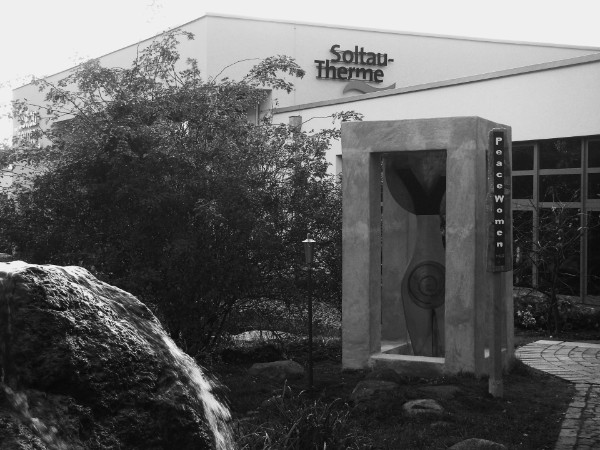Please email your comments & questions to geovisual at comcast.net. Thank you.
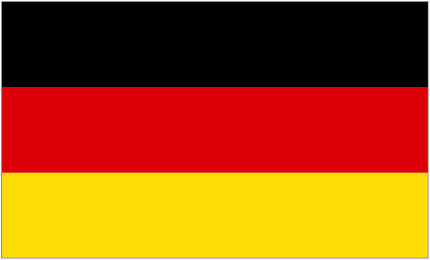

| 155 Peace Monuments in Germany
(Except Berlin & Potsdam) |
Click here for peace monuments in Berlin & Potsdam. Click here for peace monuments in Austria
Click here for Selected Anti-War Paintings & Sculptures
During & Between World Wars I & II (1914-1945)
Including the Dada Art Movement (1915-1923)
Click here for art works by Käthe Kollwitz [1867-1945].
Click here for musuems & monuments related to the Holocaust.
Click here for "Sites of Memory: Markers, Memorials, Monuments & Cemeteries" by Mark R. Hatlie, Tübingen (Germany).
See end of this webpage for a note about mahnmal & denkmal.
Right click image to enlarge / Zum Vergrößern auf das Bild klicken.

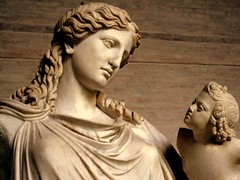
 |  c370 BCE - Statue of Irene / Eirene, Glyptothek, Munich (Germany). Greek Goddess of Peace.
Roman copy of a votive statue executed in bronze by Cephisodotus the Elder (perhaps the father or uncle of Praxieles) & set up in the Agora of Athens after 371 BC to commemorate the Common Peace / Koine Eirene of that year. Although the statue is now lost, it was copied in marble by the Romans, and one of the best surviving copies is in the Munich Glyptothek. 1 of 40 monuments in "Peace Symbols" by Zonia Baber (1948), pp. 8-9. According to Baber, "there is no known record of a statue personifying peace produdced earlier than this one of Irene." c370 BCE - Statue of Irene / Eirene, Glyptothek, Munich (Germany). Greek Goddess of Peace.
Roman copy of a votive statue executed in bronze by Cephisodotus the Elder (perhaps the father or uncle of Praxieles) & set up in the Agora of Athens after 371 BC to commemorate the Common Peace / Koine Eirene of that year. Although the statue is now lost, it was copied in marble by the Romans, and one of the best surviving copies is in the Munich Glyptothek. 1 of 40 monuments in "Peace Symbols" by Zonia Baber (1948), pp. 8-9. According to Baber, "there is no known record of a statue personifying peace produdced earlier than this one of Irene." 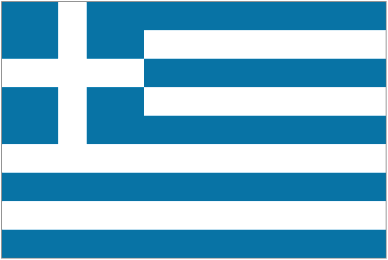 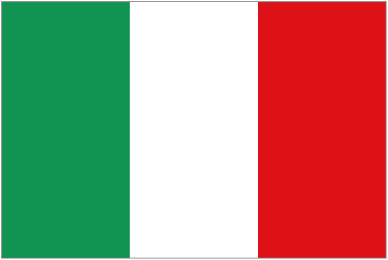
|
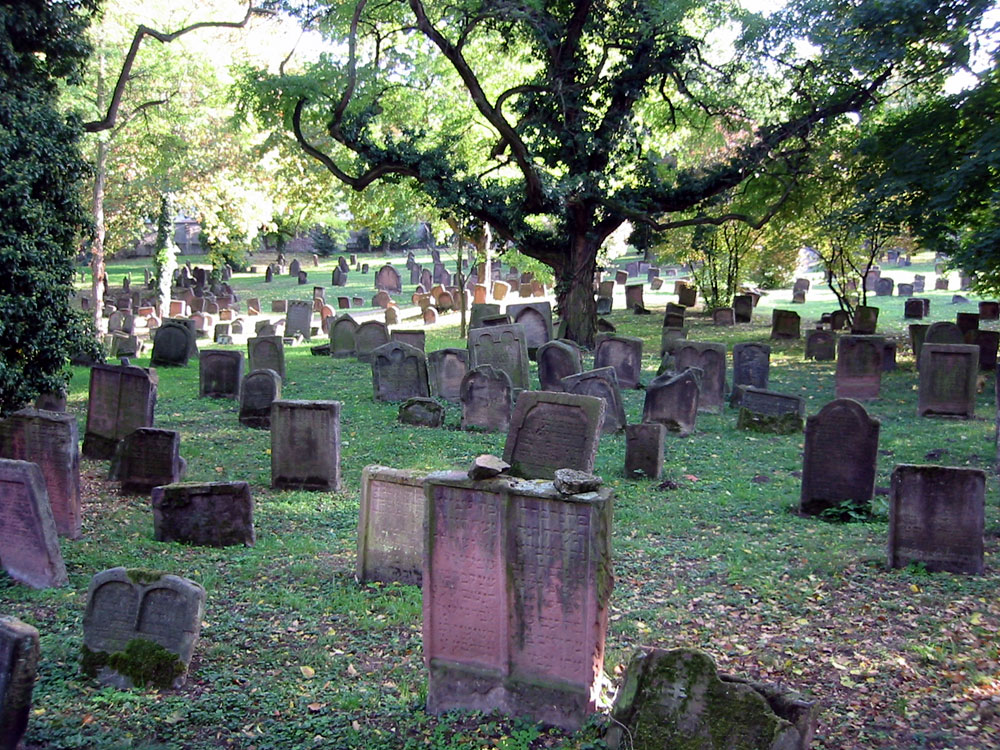

|  About 1059 - Heiliger Sand / Jewish Cemetery, Worms (Germany). Date is the oldest tombstone still legible. Cemetery is "usually called the oldest surviving Jewish cemetery in Europe (although the Jewish burials in the Jewish sections of the Roman catacombs predate it by a millennium).
The Jewish community of Worms was established by the early 11th century. The older part contains still about 1300 tombstones, the newer part (on the wall of the former city fortifications), acquired after 1689, more than 1200." Survived the Nazi era. /// "The other notable Jewish site in Worms is the Rashi synagogue, which dates from 1175 & is named after the famous medieval Torah commentator who spent a part of his career there. In the adjoining museum devoted to the history of the Jews of Worms, there is a chilling photograph of the synagogue going up in flames during Kristallnacht in 1938 when much of the Jewish Quarter was destroyed. The local fire brigade is on the scene & firefighters can be seen aiming their hoses directly away from the synagogue to protect nearby German homes & buildings." About 1059 - Heiliger Sand / Jewish Cemetery, Worms (Germany). Date is the oldest tombstone still legible. Cemetery is "usually called the oldest surviving Jewish cemetery in Europe (although the Jewish burials in the Jewish sections of the Roman catacombs predate it by a millennium).
The Jewish community of Worms was established by the early 11th century. The older part contains still about 1300 tombstones, the newer part (on the wall of the former city fortifications), acquired after 1689, more than 1200." Survived the Nazi era. /// "The other notable Jewish site in Worms is the Rashi synagogue, which dates from 1175 & is named after the famous medieval Torah commentator who spent a part of his career there. In the adjoining museum devoted to the history of the Jews of Worms, there is a chilling photograph of the synagogue going up in flames during Kristallnacht in 1938 when much of the Jewish Quarter was destroyed. The local fire brigade is on the scene & firefighters can be seen aiming their hoses directly away from the synagogue to protect nearby German homes & buildings."
|

|  May 15, 1648 - Friedenssall / Peace Hall, Rathaus / City Hall, Osnabrück, Lower Saxony (Germany). This room and a similar room in Münster became "unintentional monuments" with the signing of the Peace of Westphalia ending the Thirty Years' War (1618–1648) in the Holy Roman Empire and the Eighty Years' War (1568–1648) between Spain and the Republic of the Seven United Netherlands after the first modern diplomatic congress -- thereby initiating a new political order in central Europe based upon the concept of a sovereign state governed by a sovereign. The Osnabrück City Hall was built from 1487 to 1512 in late Gothic style. It is one of the major landmarks and influential buildings in the city of Osnabrück and is still used as a city hall building. May 15, 1648 - Friedenssall / Peace Hall, Rathaus / City Hall, Osnabrück, Lower Saxony (Germany). This room and a similar room in Münster became "unintentional monuments" with the signing of the Peace of Westphalia ending the Thirty Years' War (1618–1648) in the Holy Roman Empire and the Eighty Years' War (1568–1648) between Spain and the Republic of the Seven United Netherlands after the first modern diplomatic congress -- thereby initiating a new political order in central Europe based upon the concept of a sovereign state governed by a sovereign. The Osnabrück City Hall was built from 1487 to 1512 in late Gothic style. It is one of the major landmarks and influential buildings in the city of Osnabrück and is still used as a city hall building.
|



|  1774? - Der Friede / Statue of Peace, Puppenbrücke / Statue Bridge, Lübeck (Germany). One of 8 statues created by Diedrich Jurgen Boy in 1774. The originals suffered badly from air pollution & have been in the St. Annen Museum since 1985. The other 7 statues are of the river god Trave, Harmony, Courage, Wisdom, Freedom, Mercury & Neptune. Visited by EWL 5 Sept 2013. 1774? - Der Friede / Statue of Peace, Puppenbrücke / Statue Bridge, Lübeck (Germany). One of 8 statues created by Diedrich Jurgen Boy in 1774. The originals suffered badly from air pollution & have been in the St. Annen Museum since 1985. The other 7 statues are of the river god Trave, Harmony, Courage, Wisdom, Freedom, Mercury & Neptune. Visited by EWL 5 Sept 2013.
|
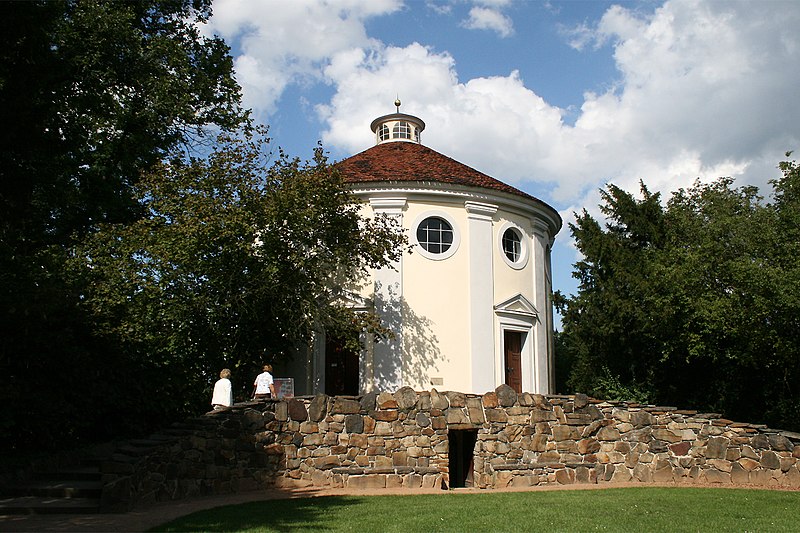


|  1790 - Toleranzblick / "Tolerance View," Wörlitz Garden Realm, Wörlitz, Wittenberg, Saxony-Anhalt, (Germany). "From here you see the Wörlitz Synagogue on the left for the Jewish religion & the Christian church on the right -- both should be equal in the eye of the visitor." /// "In the 18th century, a prince of Anhalt-Dessau made a park that was his vision of paradise. An Arcadian place of temples & grottoes & lovely lakes, a hymn to the Enlightenment, where a Toleranzblick, or "view of tolerance," offers the sight of a round synagogue built in the guise of a Roman temple and, behind it, a Gothic church tower.
We know what happened to tolerance in this part of Germany between 1933 and 1989. Still the prince dreamed, which is important." /// "Since 2003 the synagogue has been restored & is now a small museum showcasing the history of the Jewish community of Wörlitz." 1790 - Toleranzblick / "Tolerance View," Wörlitz Garden Realm, Wörlitz, Wittenberg, Saxony-Anhalt, (Germany). "From here you see the Wörlitz Synagogue on the left for the Jewish religion & the Christian church on the right -- both should be equal in the eye of the visitor." /// "In the 18th century, a prince of Anhalt-Dessau made a park that was his vision of paradise. An Arcadian place of temples & grottoes & lovely lakes, a hymn to the Enlightenment, where a Toleranzblick, or "view of tolerance," offers the sight of a round synagogue built in the guise of a Roman temple and, behind it, a Gothic church tower.
We know what happened to tolerance in this part of Germany between 1933 and 1989. Still the prince dreamed, which is important." /// "Since 2003 the synagogue has been restored & is now a small museum showcasing the history of the Jewish community of Wörlitz."
|


|  October 1-November, 1818 - Congress of Aix-la-Chappelle, Aachen, North Rhine-Westphalia (Germany). "Primarily a meeting of the four allied powers - Britain, Austria, Prussia & Russia - to decide the question of the withdrawal of the army of occupation from France & the nature of the modifications to be introduced in consequence into the relations of the four powers towards each other, and collectively towards France. This was the third conference to bear that name; the first took place in 1668, the second in 1748." Image shows congress memorial in Aachen. October 1-November, 1818 - Congress of Aix-la-Chappelle, Aachen, North Rhine-Westphalia (Germany). "Primarily a meeting of the four allied powers - Britain, Austria, Prussia & Russia - to decide the question of the withdrawal of the army of occupation from France & the nature of the modifications to be introduced in consequence into the relations of the four powers towards each other, and collectively towards France. This was the third conference to bear that name; the first took place in 1668, the second in 1748." Image shows congress memorial in Aachen.
|

|   1850 - Paulskirche, Frankfurt (Germany). "Seat of course of the 1848-49 parliament [the first publicly and freely elected body of Germany], but also of the August 1850 international peace congress (of the peace movement). If I remember well, there are some reminders of this inside the building. I visited it at least once, when I received an invitation to attend the award of Germany’s most important peace prize, the one awarded by the German book trade (Friedenspreis des Deutschen Buchhandels). The annual ceremony is being held here. In my view, it comes second, after the Nobel, in terms of the elaborateness of the ceremony, the dignity of the occasion, the standing in the country, the documentation which is produced, etc. It follows the Nobel at some distance, but that is inevitable (no royalty involved, the prize money is less, the outside world hardly takes notice, etc.). It has interesting origins, not long after World War II." 1850 - Paulskirche, Frankfurt (Germany). "Seat of course of the 1848-49 parliament [the first publicly and freely elected body of Germany], but also of the August 1850 international peace congress (of the peace movement). If I remember well, there are some reminders of this inside the building. I visited it at least once, when I received an invitation to attend the award of Germany’s most important peace prize, the one awarded by the German book trade (Friedenspreis des Deutschen Buchhandels). The annual ceremony is being held here. In my view, it comes second, after the Nobel, in terms of the elaborateness of the ceremony, the dignity of the occasion, the standing in the country, the documentation which is produced, etc. It follows the Nobel at some distance, but that is inevitable (no royalty involved, the prize money is less, the outside world hardly takes notice, etc.). It has interesting origins, not long after World War II."
|
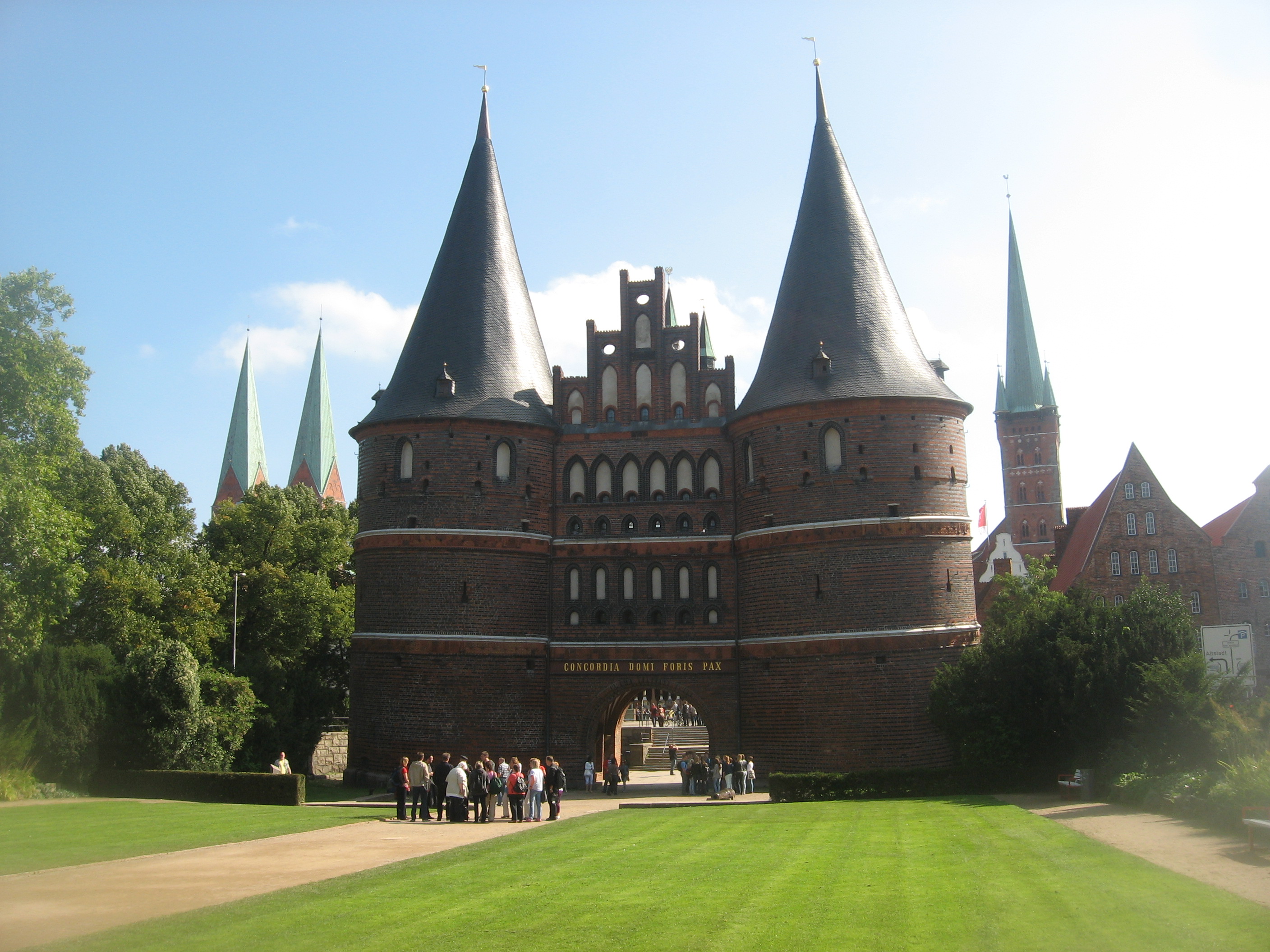 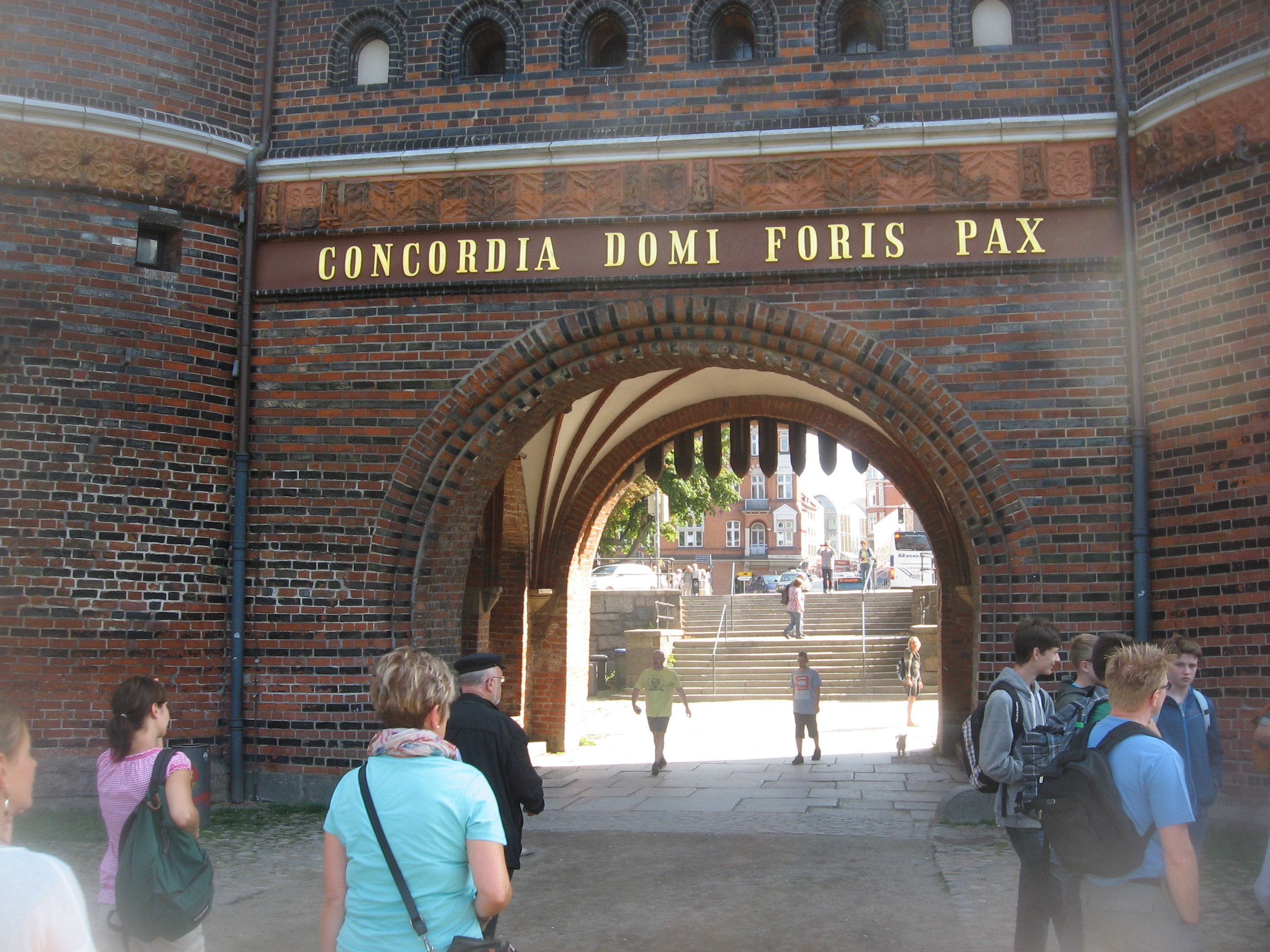
|  1871 - Holstentor / Holsten Gate, Holstentorplatz, Lübeck (Germany). Inscribed "concordia domi foris pax / harmony within, peace without." "This inscription is from 1871 and is a shortened form of the text which had previously been on the (not preserved) foregate: "Concordia domi et pax foris sane res est omnium pulcherrima. / Harmony within and peace without are indeed the greatest good of all." /// "Means literally "harmony at home, peace outside", and is more loosely translated at Wikipedia as "harmony within, peace without", making it so that domi means 'within the gates' and foris means 'without the gates.' The phrase uses a device called "chiasm," which uses one word order for the first half, and reverses it in the second. This puts concordia (harmony) and pax (peace), which are practically synonyms, as the first and last words, and puts domi (within) and foris (without) right next to each other. To preserve this in English, it would be 'harmony within; without, peace.' It is, of course, important to put a comma after "without" or use a different word altogether to prevent it from meaning "not having". Without chiasm, it would either be concordia domi pax foris or domi concilia foris pax." /// "The Holstentor is one of the most favourite buildings in Germany. The late gothic gate is at this time part of a fortification. In 1478 the main gate was finished." /// Both images by EWL 5 Sept 2013. 1871 - Holstentor / Holsten Gate, Holstentorplatz, Lübeck (Germany). Inscribed "concordia domi foris pax / harmony within, peace without." "This inscription is from 1871 and is a shortened form of the text which had previously been on the (not preserved) foregate: "Concordia domi et pax foris sane res est omnium pulcherrima. / Harmony within and peace without are indeed the greatest good of all." /// "Means literally "harmony at home, peace outside", and is more loosely translated at Wikipedia as "harmony within, peace without", making it so that domi means 'within the gates' and foris means 'without the gates.' The phrase uses a device called "chiasm," which uses one word order for the first half, and reverses it in the second. This puts concordia (harmony) and pax (peace), which are practically synonyms, as the first and last words, and puts domi (within) and foris (without) right next to each other. To preserve this in English, it would be 'harmony within; without, peace.' It is, of course, important to put a comma after "without" or use a different word altogether to prevent it from meaning "not having". Without chiasm, it would either be concordia domi pax foris or domi concilia foris pax." /// "The Holstentor is one of the most favourite buildings in Germany. The late gothic gate is at this time part of a fortification. In 1478 the main gate was finished." /// Both images by EWL 5 Sept 2013.
|
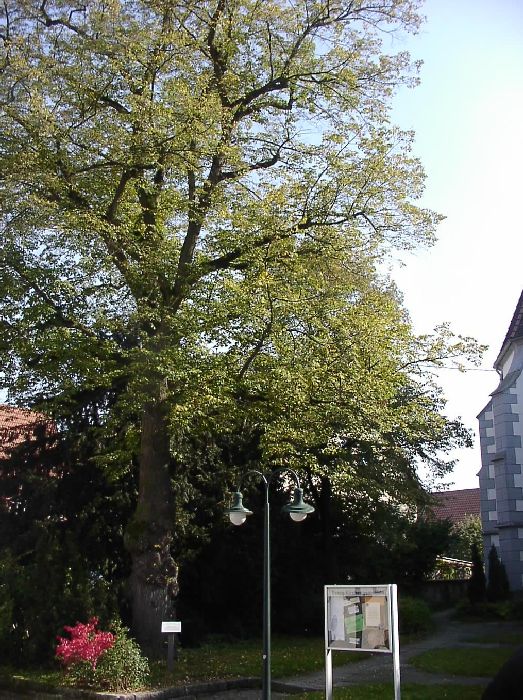


|   1871 - Friedenslinde / Peace Linden Tree, "Our Lady" Protestant Church, Town Square, Frickenhausen, near Stuttgart (Germany). Translation of plaque: "Nature Monument and Symbol of Peace / This linden tree is a protected natural monument. Primary purpose is securing and maintaining it as typical for the landscape. The top of the tree is of particular importance. / This linden tree was planted in 1871 in memory of the end of the war and peace with France. That is why it is called the 'Peace Linden.'" Photographer's commentary: "Perhaps I am too cynical, but I strongly suspect that the tree was originally a Siegeslinde / 'Victory Linden' and was only later, after WW-II, re-interpreted. But I am sending an e-mail to the local pastor. Maybe he can tell me more." Note: Many other linden trees were planted in Germany about this time to mark the end of the Franco-Prussian War (1870-1871). 1871 - Friedenslinde / Peace Linden Tree, "Our Lady" Protestant Church, Town Square, Frickenhausen, near Stuttgart (Germany). Translation of plaque: "Nature Monument and Symbol of Peace / This linden tree is a protected natural monument. Primary purpose is securing and maintaining it as typical for the landscape. The top of the tree is of particular importance. / This linden tree was planted in 1871 in memory of the end of the war and peace with France. That is why it is called the 'Peace Linden.'" Photographer's commentary: "Perhaps I am too cynical, but I strongly suspect that the tree was originally a Siegeslinde / 'Victory Linden' and was only later, after WW-II, re-interpreted. But I am sending an e-mail to the local pastor. Maybe he can tell me more." Note: Many other linden trees were planted in Germany about this time to mark the end of the Franco-Prussian War (1870-1871).
|

|  1871 Friedensdenkmal / Peace Monument, Warnemünde, Mecklenburg-Vorpommern (Germany. Errected after War of 1870. Warnemünde is a seaside resort on the Baltic Sea. 1871 Friedensdenkmal / Peace Monument, Warnemünde, Mecklenburg-Vorpommern (Germany. Errected after War of 1870. Warnemünde is a seaside resort on the Baltic Sea.
|







|  July 16, 1899 - Friedensengel / Angel of Peace, on opposite side of Luitpoldbrücke over Isar River, Munich, Bavaria (Germany).
Celebrates 25 years of peace since war with France 1870-71. Erected 1896-99 by sculptors Heinrich Duell, Georg Pezold & Max Heilmaier.
"Rising above the terraces in the axis of the Prinzregentenstrasse is the 38-metre 'Angel of Peace,' which is the dominant feature of the park and is often regarded as a symbol of Munich. Created to mark the 25 years of peace after the 1871 Treaty of Versailles, it is mounted on a 23-metre column above a small hall, and is modelled on Athena, goddess of wisdom and peace, but also goddess of 'strategic' war. She holds Nike in her hand, the goddess of victory. The Friedensengel provides a spectacular view of the city, and is sited above a superb terrace, which is unfortunately marred by heavy traffic."
Lower left image shows temple at the base of the column.
Lower right imges show Prinzregentenbrücke / Prinzregenten Bridge over the Isar (1900-01, architect: Theodor Fischer). July 16, 1899 - Friedensengel / Angel of Peace, on opposite side of Luitpoldbrücke over Isar River, Munich, Bavaria (Germany).
Celebrates 25 years of peace since war with France 1870-71. Erected 1896-99 by sculptors Heinrich Duell, Georg Pezold & Max Heilmaier.
"Rising above the terraces in the axis of the Prinzregentenstrasse is the 38-metre 'Angel of Peace,' which is the dominant feature of the park and is often regarded as a symbol of Munich. Created to mark the 25 years of peace after the 1871 Treaty of Versailles, it is mounted on a 23-metre column above a small hall, and is modelled on Athena, goddess of wisdom and peace, but also goddess of 'strategic' war. She holds Nike in her hand, the goddess of victory. The Friedensengel provides a spectacular view of the city, and is sited above a superb terrace, which is unfortunately marred by heavy traffic."
Lower left image shows temple at the base of the column.
Lower right imges show Prinzregentenbrücke / Prinzregenten Bridge over the Isar (1900-01, architect: Theodor Fischer).
|

|   August 1, 1914 - Insel Mainau / Mainau Island, Meersburg, Lake Constance (Germany). First conference of the Church Peace Union (CPU).
"The timing of the CPU's founding was significant. On the very eve of World War I, Andrew Carnegie [1835-1919] sought to make war obsolete for all time. For its inaugural international event, the CPU sponsored a conference to be held on the shores of Lake Constance in southern Germany. As the delegates made their way to the conference by train, Germany was invading Belgium." "Delegates met on 1st August, the day the Kaiser ordered mobilisation. They were allowed to leave the country on the last train to France, and then boarded a steamer for London." [PvdD 16Jul10]. August 1, 1914 - Insel Mainau / Mainau Island, Meersburg, Lake Constance (Germany). First conference of the Church Peace Union (CPU).
"The timing of the CPU's founding was significant. On the very eve of World War I, Andrew Carnegie [1835-1919] sought to make war obsolete for all time. For its inaugural international event, the CPU sponsored a conference to be held on the shores of Lake Constance in southern Germany. As the delegates made their way to the conference by train, Germany was invading Belgium." "Delegates met on 1st August, the day the Kaiser ordered mobilisation. They were allowed to leave the country on the last train to France, and then boarded a steamer for London." [PvdD 16Jul10]. 
|
 1914-1919 - World War I
1914-1919 - World War I
 |   November 11, 1918 - "International World War Peace Tree," Evansville, Indiana (USA). Press caption: "Charles and Beth Skeels stand under a shady linden, designated the 'peace tree' by German immigrants who planted it as a seedling on her family's property north of Evansville at the end of World War I." November 11, 1918 - "International World War Peace Tree," Evansville, Indiana (USA). Press caption: "Charles and Beth Skeels stand under a shady linden, designated the 'peace tree' by German immigrants who planted it as a seedling on her family's property north of Evansville at the end of World War I." 
|

 |  Date? - Anti-war monument, village de Strümpfelbach, commune de Weinstadt (Germany). Near Stuttgart. "Le monument dressé après la Première Guerre comportait l'inscription « Nie wieder Krieg !» (Plus jamais la guerre!).
Le texte "Nie wieder Krieg" était à l'origine gravé sur l'arrière du monument. Au moment de la montée du
national-socialisme [in 1933], l'ordre a été donné de faire disparaître cette inscription. On peut encore voir l'emplacement, en creux. Après la Seconde Guerre mondiale, les autorités communales décidèrent de faire graver à nouveau la même sentence, cette fois-ci sur le devant du monument." /// NB: This website contains
"73 monuments pacifistes,
68 pleureuses,
53 monuments humanistes,
9 Piétas,
27 soldats agonisants & 21 gisants," mostly in France. Date? - Anti-war monument, village de Strümpfelbach, commune de Weinstadt (Germany). Near Stuttgart. "Le monument dressé après la Première Guerre comportait l'inscription « Nie wieder Krieg !» (Plus jamais la guerre!).
Le texte "Nie wieder Krieg" était à l'origine gravé sur l'arrière du monument. Au moment de la montée du
national-socialisme [in 1933], l'ordre a été donné de faire disparaître cette inscription. On peut encore voir l'emplacement, en creux. Après la Seconde Guerre mondiale, les autorités communales décidèrent de faire graver à nouveau la même sentence, cette fois-ci sur le devant du monument." /// NB: This website contains
"73 monuments pacifistes,
68 pleureuses,
53 monuments humanistes,
9 Piétas,
27 soldats agonisants & 21 gisants," mostly in France. 
|
|

|  1927-1937, 1953 - Güstrower Ehrenmal, Güstrower Cathedral, Güstrow (Germany). Also called "Der Schwebende / The Hovering" & "Floating Angel." By Ernst Barlach [1870-1938]. "A memorial for the victims of the First World War for the Güstrow Cathedral in the 700th anniversary of the building. The original was removed from the Güstrower Cathedral in 1937 as a so-called Entartete art & later melted [down]. Since the factory model was destroyed in a bomb attack, the Cologne second cast served as a template for a new mold. This enabled a third cast of the Barlachian angel in 1953, which since 8 March 1953 hovered again (with interruptions) in its original place in the Güstrower Dom. "Germany - Memories of a Nation "was as exhibition from 16 October 2014 to 25 January 2015 in the British Museum, London. The Hovering as one of the most impressive sculptures of the 20th century was one of the highlights of the show." [Google translation] 1927-1937, 1953 - Güstrower Ehrenmal, Güstrower Cathedral, Güstrow (Germany). Also called "Der Schwebende / The Hovering" & "Floating Angel." By Ernst Barlach [1870-1938]. "A memorial for the victims of the First World War for the Güstrow Cathedral in the 700th anniversary of the building. The original was removed from the Güstrower Cathedral in 1937 as a so-called Entartete art & later melted [down]. Since the factory model was destroyed in a bomb attack, the Cologne second cast served as a template for a new mold. This enabled a third cast of the Barlachian angel in 1953, which since 8 March 1953 hovered again (with interruptions) in its original place in the Güstrower Dom. "Germany - Memories of a Nation "was as exhibition from 16 October 2014 to 25 January 2015 in the British Museum, London. The Hovering as one of the most impressive sculptures of the 20th century was one of the highlights of the show." [Google translation] 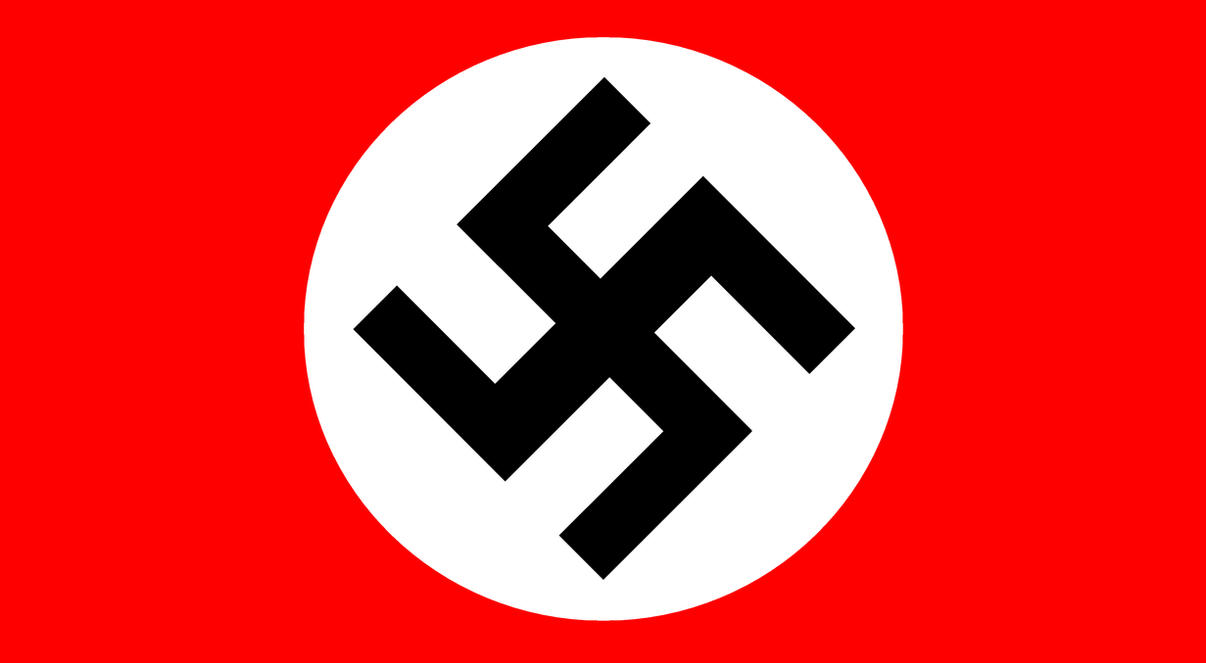
|
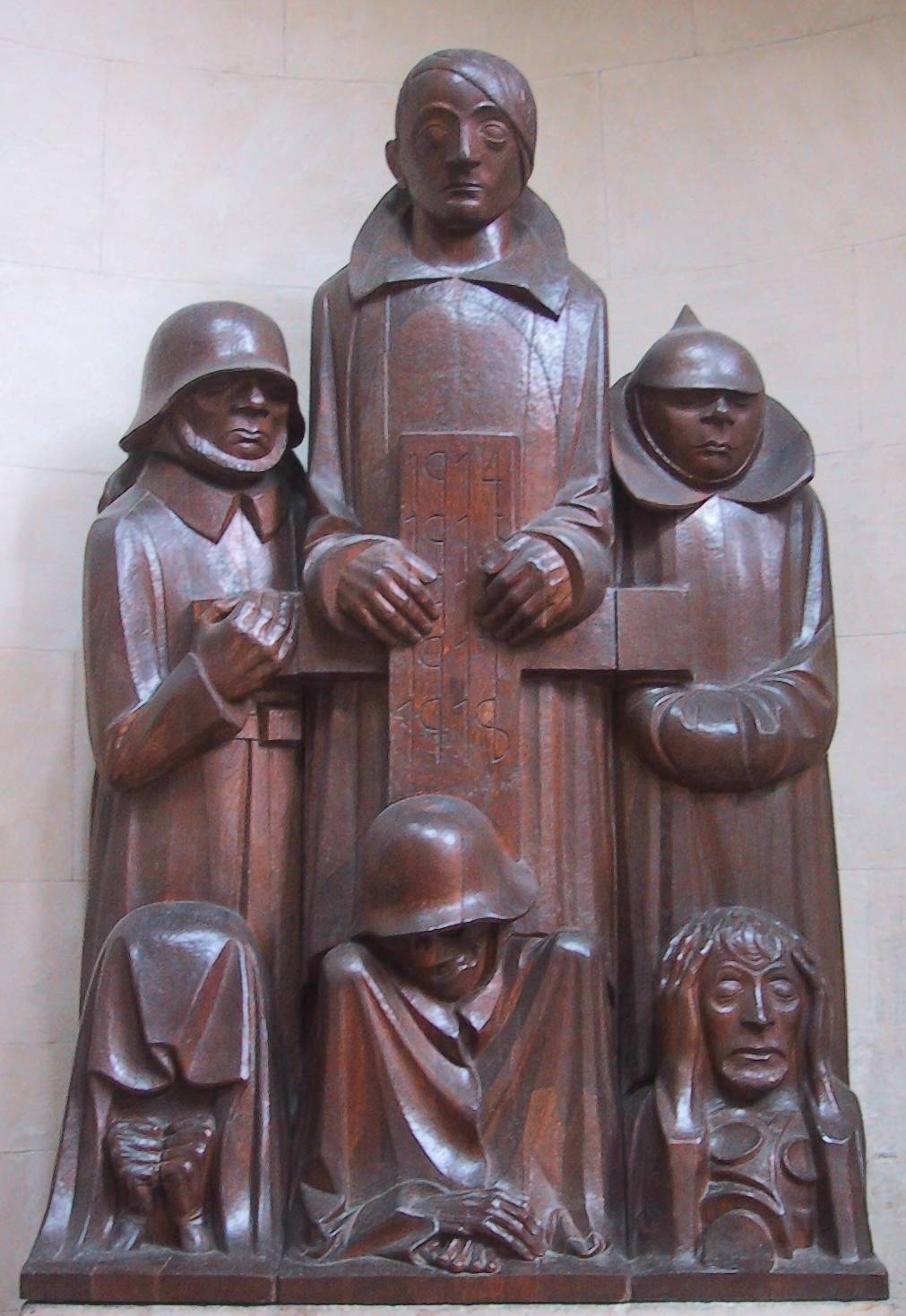
 |  1929 - Magdeburger Ehrenmal/Magdeburg Cenotaph, Magdeburg Cathedral,
Magdeburg Saxony-Anhalt (Germany). By Ernst Barlach [1870-1938]. "Ordered by the city of Magdeburg to be a memorial of World War I. Was expected to show heroic German soldiers fighting for their glorious country. Barlach, however, created a sculpture with three German soldiers, a fresh recruit, a young officer & an old reservist, standing in a cemetery, all bearing marks of the horror, pain & desperation of the war, flanked by a mourning war widow covering her face in despair, a skeleton wearing a German army helmet & a civilian (the face is that of Barlach himself) with his eyes closed & blocking his ears in terror. This naturally created a controversy with the pro-war population (several nationalists & Nazis claimed that the soldiers must be foreign since true Germans would be more heroic), and the sculpture was removed [when?]. Friends of Barlach were able to hide it until after the [Second?] war, when it was returned to the Magdeburg Cathedral..." 1929 - Magdeburger Ehrenmal/Magdeburg Cenotaph, Magdeburg Cathedral,
Magdeburg Saxony-Anhalt (Germany). By Ernst Barlach [1870-1938]. "Ordered by the city of Magdeburg to be a memorial of World War I. Was expected to show heroic German soldiers fighting for their glorious country. Barlach, however, created a sculpture with three German soldiers, a fresh recruit, a young officer & an old reservist, standing in a cemetery, all bearing marks of the horror, pain & desperation of the war, flanked by a mourning war widow covering her face in despair, a skeleton wearing a German army helmet & a civilian (the face is that of Barlach himself) with his eyes closed & blocking his ears in terror. This naturally created a controversy with the pro-war population (several nationalists & Nazis claimed that the soldiers must be foreign since true Germans would be more heroic), and the sculpture was removed [when?]. Friends of Barlach were able to hide it until after the [Second?] war, when it was returned to the Magdeburg Cathedral..."
|

|  1929–1932 - Triptych "Der Krieg / The War," Galerie Neue Meister, Dresden (Germany). By Otto Dix [1891-1969]. "One of the key works of German realist painting from the 20th century. In the style of an Old Master, the four panels reveal the 'great seminal catastrophe of the 20th century,' showing troops setting off at daybreak (left panel), the battlefield as a place of death (central panel), soldiers returning from the hell of battle (right panel) & fallen soldiers resting in peace in a dugout (predella)." 1929–1932 - Triptych "Der Krieg / The War," Galerie Neue Meister, Dresden (Germany). By Otto Dix [1891-1969]. "One of the key works of German realist painting from the 20th century. In the style of an Old Master, the four panels reveal the 'great seminal catastrophe of the 20th century,' showing troops setting off at daybreak (left panel), the battlefield as a place of death (central panel), soldiers returning from the hell of battle (right panel) & fallen soldiers resting in peace in a dugout (predella)."
|
 1933-1945 - Hitlerzeit / Hitler Era
1933-1945 - Hitlerzeit / Hitler Era
 1939-1945 - World War II (Ending with Partition of Germany)
1939-1945 - World War II (Ending with Partition of Germany)
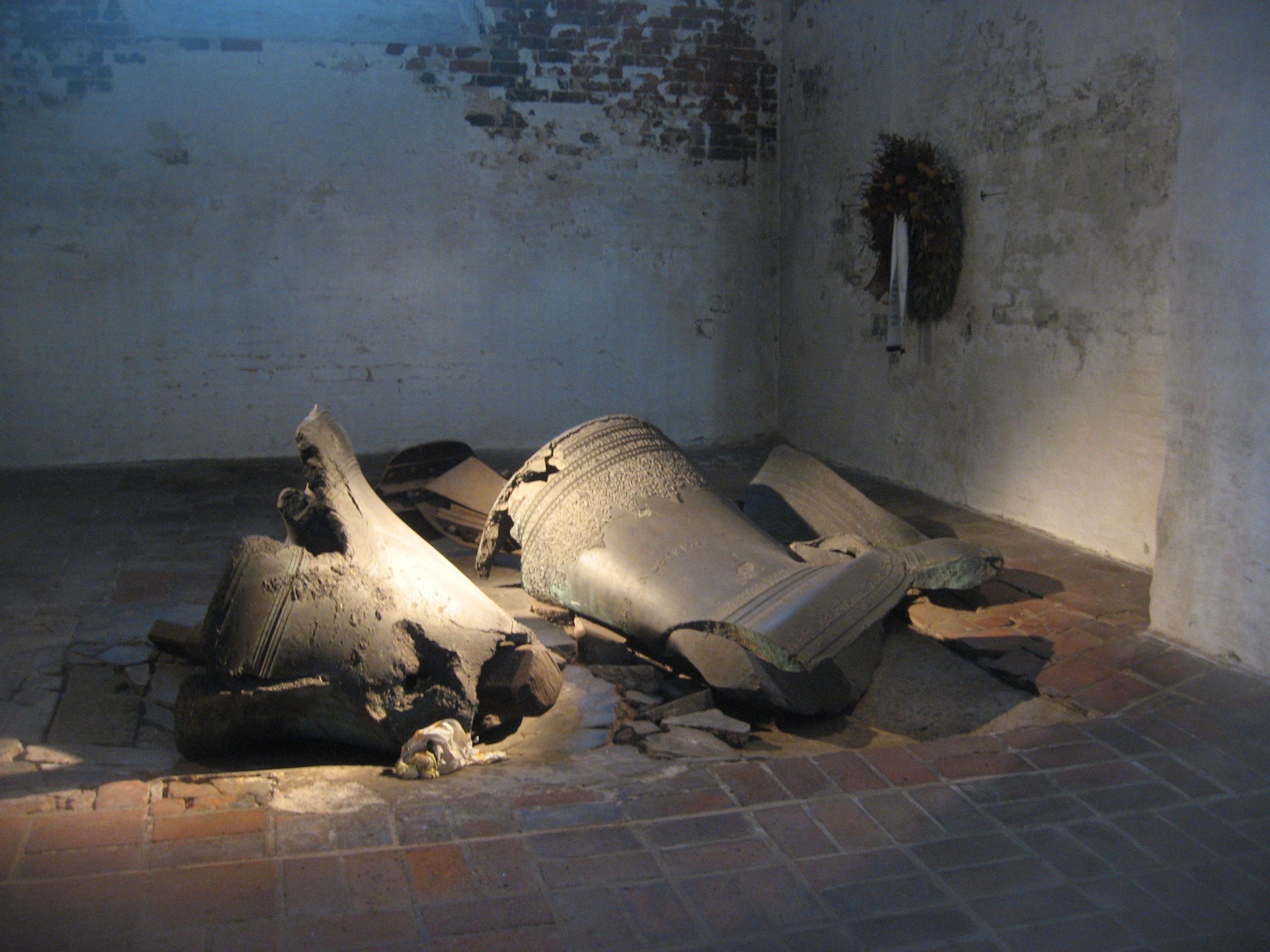 
 |  March 28-29, 1942 - Gefallene Glocken / Broken Bells, Marienkirche / St. Mary's Church, Lübeck (Germany). Unintentional monument. "On the night of Palm Sunday from 28 to 29 March 1942, the church was almost completely burnt out during an Allied bombing raid along with about a fifth of Lübeck city centre, including the Lübeck Cathedral and St. Peter's Church... The bells of the church, which fell down during the ensuing blaze, lie where they fell to this day, where they remain as a memorial. They can be seen in the Gedenkkapelle in the south tower." Both images by EWL 5 Sept 2013. March 28-29, 1942 - Gefallene Glocken / Broken Bells, Marienkirche / St. Mary's Church, Lübeck (Germany). Unintentional monument. "On the night of Palm Sunday from 28 to 29 March 1942, the church was almost completely burnt out during an Allied bombing raid along with about a fifth of Lübeck city centre, including the Lübeck Cathedral and St. Peter's Church... The bells of the church, which fell down during the ensuing blaze, lie where they fell to this day, where they remain as a memorial. They can be seen in the Gedenkkapelle in the south tower." Both images by EWL 5 Sept 2013.
|



| C
H
U
R
C
H | S
T
O
N
E
S |  1949 & ongoing - Memorial Stones, Pax Christi Kirche / Pax Christi Church,
Essen-Bergerhausen (Germany). "1,100 names have so far been inscribed... 'from all peoples + tribes + nations + languages + religions,' hence names of Christians, Jews, Moslems, Believers and Non-Believers, soldiers killed in action, concentration camp victims as well as names of people who have been killed by the mafia, by terrorism or by violence of different kinds in wars, in the streets here and in houses today. The names are baked into clay tablets and inserted into the floor of the lower church (the church comprises two levels). There are also 80 names of countries and places... Belfast / Stalingrad / Biafra / Lhasa / Temesvar /
München 1972 /
Peking 1989 /
Heysel-Stadion 1985 /
Melanie and Karola Weimar /
Hanns-Martin Schleyer and his driver Heinz Marcisz / John Lennon /
Dietrich Bonnhoeffer / John F. Kenney [sic] / 900 people of the People’s Temple sect [of Jim Jones], driven to their deaths /
Savonarola /
Sophie und Hans Scholl /
Edith Stein /
Pater Alfred Delp /
Erich Klausener /
Nikolaus Groß /
Maximilian Kolbe /
Anna Göldin – the last witch to be executed in Europe /
seven Trappists assassinated in Algeria in 1996 / girls and young women from Flanders, sexually abused and murdered in 1966 for the pornographic scene / names which conjure up a sense of horror and grief: Trebl.maripo.com/p_inmp.htm">International Network of Museums for Peace (INMP). 1949 & ongoing - Memorial Stones, Pax Christi Kirche / Pax Christi Church,
Essen-Bergerhausen (Germany). "1,100 names have so far been inscribed... 'from all peoples + tribes + nations + languages + religions,' hence names of Christians, Jews, Moslems, Believers and Non-Believers, soldiers killed in action, concentration camp victims as well as names of people who have been killed by the mafia, by terrorism or by violence of different kinds in wars, in the streets here and in houses today. The names are baked into clay tablets and inserted into the floor of the lower church (the church comprises two levels). There are also 80 names of countries and places... Belfast / Stalingrad / Biafra / Lhasa / Temesvar /
München 1972 /
Peking 1989 /
Heysel-Stadion 1985 /
Melanie and Karola Weimar /
Hanns-Martin Schleyer and his driver Heinz Marcisz / John Lennon /
Dietrich Bonnhoeffer / John F. Kenney [sic] / 900 people of the People’s Temple sect [of Jim Jones], driven to their deaths /
Savonarola /
Sophie und Hans Scholl /
Edith Stein /
Pater Alfred Delp /
Erich Klausener /
Nikolaus Groß /
Maximilian Kolbe /
Anna Göldin – the last witch to be executed in Europe /
seven Trappists assassinated in Algeria in 1996 / girls and young women from Flanders, sexually abused and murdered in 1966 for the pornographic scene / names which conjure up a sense of horror and grief: Trebl.maripo.com/p_inmp.htm">International Network of Museums for Peace (INMP).
|

From
1953 |

Since
2011
| 
 January 27, 1953 - Friedensglocke / Peace Bell, Oder Promenade, Frankfurt an der Oder (Germany). "A monument to the Oder-Neisse line, which was then called the Oder-Neisse border of peace. The GDR had accepted the Oder-Neisse line with the Treaty of Zgorzelec already 1949th Frankfurt (Oder) was Polish border town & the eastern neighborhoods as Slubice. Traditionally, the bell is rung on 1 September World Peace Day [sic].
The Peace Bell is a three-ton iron chilled cast iron bell, which was cast in Morgenrothe im Vogtland. It bears the inscription peace & friendship with all peoples. The bell was of the CDU in the GDR to VI. Congress instituted on January 27, 1953.
The bell hung to 2011 in a building designed by Johannes Muller Glockenhaus am Holzmarkt.
2002 decided to put the bell to the southern end of the timber market. 2011 a new bell tower by architects Gruber + Popp was built. The bell was removed on February 2, 2011, from the bell tower and then redeveloped in Neuenhagen bei Berlin. The total cost of the renovation and the new bell tower amounted to around EUR 250,000. A stone slab with a presentation from the interior of the old belfry was attached next to the new globe tabs. [6] on August 30, 2011, the new location of the peace bell on the Oder promenade was inaugurated. The bell is now framed & supported by a steel tower." [Google translation]. January 27, 1953 - Friedensglocke / Peace Bell, Oder Promenade, Frankfurt an der Oder (Germany). "A monument to the Oder-Neisse line, which was then called the Oder-Neisse border of peace. The GDR had accepted the Oder-Neisse line with the Treaty of Zgorzelec already 1949th Frankfurt (Oder) was Polish border town & the eastern neighborhoods as Slubice. Traditionally, the bell is rung on 1 September World Peace Day [sic].
The Peace Bell is a three-ton iron chilled cast iron bell, which was cast in Morgenrothe im Vogtland. It bears the inscription peace & friendship with all peoples. The bell was of the CDU in the GDR to VI. Congress instituted on January 27, 1953.
The bell hung to 2011 in a building designed by Johannes Muller Glockenhaus am Holzmarkt.
2002 decided to put the bell to the southern end of the timber market. 2011 a new bell tower by architects Gruber + Popp was built. The bell was removed on February 2, 2011, from the bell tower and then redeveloped in Neuenhagen bei Berlin. The total cost of the renovation and the new bell tower amounted to around EUR 250,000. A stone slab with a presentation from the interior of the old belfry was attached next to the new globe tabs. [6] on August 30, 2011, the new location of the peace bell on the Oder promenade was inaugurated. The bell is now framed & supported by a steel tower." [Google translation]. 
| 
|

|   1953-1957 - Birkenkopf / Rubble Hill, south west of Stuttgart (Germany). Plaque says, "raised 40.2 meters from 1953 to 1957 / by piling up 1.5 million cubic meters of rubble from Stuttgart which had been 45% destroyed by 53 air attacks during WW-II." There is a path going up to the cross at the top. Now a popular area for short hikes. Refered to locally as "Monte Scherbelino," a jocular Italian-sounding name based on the German word Scherbe, meaning "shard" - "Mountain of shards." Info & Image from Mark Hatlie. 1953-1957 - Birkenkopf / Rubble Hill, south west of Stuttgart (Germany). Plaque says, "raised 40.2 meters from 1953 to 1957 / by piling up 1.5 million cubic meters of rubble from Stuttgart which had been 45% destroyed by 53 air attacks during WW-II." There is a path going up to the cross at the top. Now a popular area for short hikes. Refered to locally as "Monte Scherbelino," a jocular Italian-sounding name based on the German word Scherbe, meaning "shard" - "Mountain of shards." Info & Image from Mark Hatlie.
|
 

|  1954 - Friedensdenkmal bei Alexisbad / Peace Monument, District of Harz, Saxony-Anhalt (Germany). "Stands on a fence spur east of Alexisbad. In the background you see a part of [the Morada Hotel] in the village. The brick stone base was erected in 1813 by order of Alexius - Duke of Anhalt [1767-1834]. On it was a large iron cross. The monument presented a dedication to his son-in-law Friedrich Prinz of Prussia.
The Iron Cross was probably removed in the era after the end of the Second World War. In 1954 the conversion to a peace monument, created according to the then-time spirit & created by the Harzgeröder artist Paul Eincke, took place. It bears the inscription 'Peace of the World' & shows a peace dove over a world globe, the ultimate peace symbol in the German Democratic Republic." Click here for YouTube video. One of 15 peace monuments found in July 2017 by Googling "Friedensdenkmal" or "Friedensmahnmal." GLOBE DOVE 1954 - Friedensdenkmal bei Alexisbad / Peace Monument, District of Harz, Saxony-Anhalt (Germany). "Stands on a fence spur east of Alexisbad. In the background you see a part of [the Morada Hotel] in the village. The brick stone base was erected in 1813 by order of Alexius - Duke of Anhalt [1767-1834]. On it was a large iron cross. The monument presented a dedication to his son-in-law Friedrich Prinz of Prussia.
The Iron Cross was probably removed in the era after the end of the Second World War. In 1954 the conversion to a peace monument, created according to the then-time spirit & created by the Harzgeröder artist Paul Eincke, took place. It bears the inscription 'Peace of the World' & shows a peace dove over a world globe, the ultimate peace symbol in the German Democratic Republic." Click here for YouTube video. One of 15 peace monuments found in July 2017 by Googling "Friedensdenkmal" or "Friedensmahnmal." GLOBE DOVE
|


|  Date? - Friedensmahnmal / Peace Monument, ______ (Germany). "Gedenken zum 50. Jahrestag der Befreiung" One of 15 peace monuments found in July 2017 by Googling "Friedensdenkmal" or "Friedensmahnmal." Date? - Friedensmahnmal / Peace Monument, ______ (Germany). "Gedenken zum 50. Jahrestag der Befreiung" One of 15 peace monuments found in July 2017 by Googling "Friedensdenkmal" or "Friedensmahnmal."
|


|  Date? - Friedensmahnmal / Peace Monument, München (Germany). "Künstler macht aus Kriegerdenkmal ein Friedensmahnmal. / Artist made a peace memorial from a War Memorial." One of 15 peace monuments found in July 2017 by Googling "Friedensdenkmal" or "Friedensmahnmal." Date? - Friedensmahnmal / Peace Monument, München (Germany). "Künstler macht aus Kriegerdenkmal ein Friedensmahnmal. / Artist made a peace memorial from a War Memorial." One of 15 peace monuments found in July 2017 by Googling "Friedensdenkmal" or "Friedensmahnmal."
|
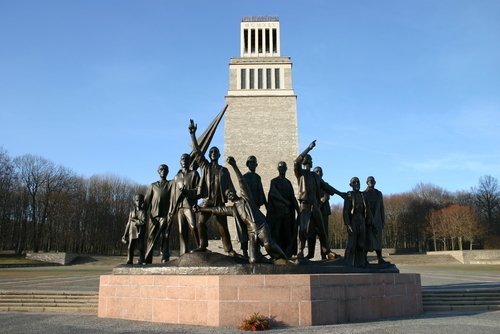

![]()

|  September 14, 1958 - Nationale Mahn- und Gedenkstätte Buchenwald / Buchenwald Memorial, Ettersberg / Etter Mountain, near Weimar, Thuringia (Germany). Site of Konzentrationslager (KZ) Buchenwald / Buchenwald concentration camp which was established in July 1937 and was one of the first and the largest Nazi concentration camp on German soil. From 1945 to 1950, the camp was used by the Soviet occupation authorities as an internment camp (NKVD special camp number 2). From 1958 to 1990, this was the "Red Olympus," the "holiest shrine of the German Democratic Republic." Chairman of the prewar German Communist Party Ernest Thälmann [1886-1944] was murdered here. Click here for a guide to Buchenwald's many Communist monuments, including Bell Tower & sculpture by Fritz Cremer [1906-1993] depicting Buchenwald resistance fighters (upper image) & Street of Nations honoring victims from 18 different countries (lower image). [Ian Buruma (1994), "The Wages of Guilt," pp. 209-17.] September 14, 1958 - Nationale Mahn- und Gedenkstätte Buchenwald / Buchenwald Memorial, Ettersberg / Etter Mountain, near Weimar, Thuringia (Germany). Site of Konzentrationslager (KZ) Buchenwald / Buchenwald concentration camp which was established in July 1937 and was one of the first and the largest Nazi concentration camp on German soil. From 1945 to 1950, the camp was used by the Soviet occupation authorities as an internment camp (NKVD special camp number 2). From 1958 to 1990, this was the "Red Olympus," the "holiest shrine of the German Democratic Republic." Chairman of the prewar German Communist Party Ernest Thälmann [1886-1944] was murdered here. Click here for a guide to Buchenwald's many Communist monuments, including Bell Tower & sculpture by Fritz Cremer [1906-1993] depicting Buchenwald resistance fighters (upper image) & Street of Nations honoring victims from 18 different countries (lower image). [Ian Buruma (1994), "The Wages of Guilt," pp. 209-17.]  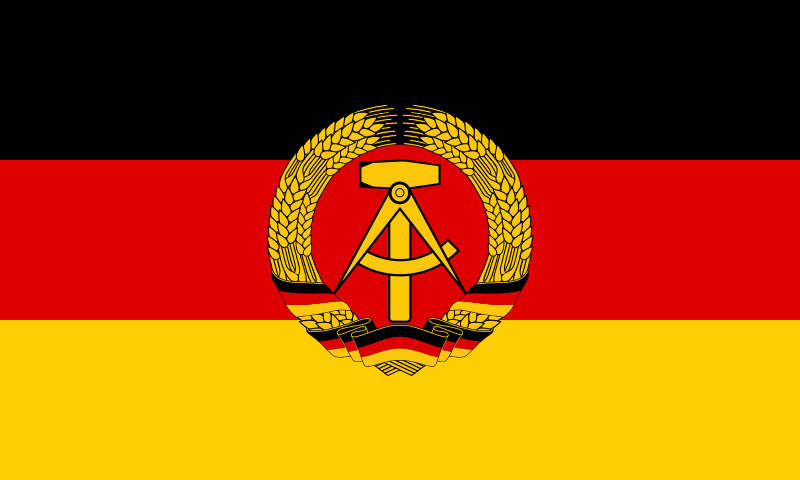
|



|  1965 - "Produktion im Frieden / Production in Peace," Eisenhüttenstadt (Germany). "East German artist Walter Womacka [1925-2010] created this mosaic in 1965 for the exterior of the former Magnet Department Store. The building designed by Otto Lopp & Otto Schnabel was constructed in 1958-1960 & has since become the Linden Center, which houses a store & library. Originally known as Stalinstadt, Eisenhüttenstadt is a small industrial city on the border of Germany & Poland that was built in the 1950's by the Germany Democratic Republic (GDR)." 1965 - "Produktion im Frieden / Production in Peace," Eisenhüttenstadt (Germany). "East German artist Walter Womacka [1925-2010] created this mosaic in 1965 for the exterior of the former Magnet Department Store. The building designed by Otto Lopp & Otto Schnabel was constructed in 1958-1960 & has since become the Linden Center, which houses a store & library. Originally known as Stalinstadt, Eisenhüttenstadt is a small industrial city on the border of Germany & Poland that was built in the 1950's by the Germany Democratic Republic (GDR)." 
| 
|  1975 - The stamp of Walter Womacka's Produktion im Frieden was issued in 1975. 1975 - The stamp of Walter Womacka's Produktion im Frieden was issued in 1975.
|

|
 1972 - Das Deutsche Haus (Bando), Naruto, Tokushima (Japan). "The site of a World War I POW camp for German soldiers. Stone bridges & cenotaph built by the prisoners are on display, along with documents about life during those times. The German prisoners were free to communicate with the local people, and much German culture remains in the area to this day. The present-day German House was built in 1993." 1972 - Das Deutsche Haus (Bando), Naruto, Tokushima (Japan). "The site of a World War I POW camp for German soldiers. Stone bridges & cenotaph built by the prisoners are on display, along with documents about life during those times. The German prisoners were free to communicate with the local people, and much German culture remains in the area to this day. The present-day German House was built in 1993." 
|


|  October 1973 - Bust of Max Josef Metzger (1887-1944), Augsburg Cathedral (South Side), Augsburg (Germany). Sculpted by Hans Ladner. Inscription: "Fur den Frieden der Welt und die Einheit der Kirche./For world peace and church unity." Information courtesy of Gerard Lössbroek 01Feb13. October 1973 - Bust of Max Josef Metzger (1887-1944), Augsburg Cathedral (South Side), Augsburg (Germany). Sculpted by Hans Ladner. Inscription: "Fur den Frieden der Welt und die Einheit der Kirche./For world peace and church unity." Information courtesy of Gerard Lössbroek 01Feb13.
|

|  Date? - Gedenktafel/Memorial plaque for Max Josef Metzger (1887-1944), Willdenowstraße 8, Berlin-Wedding (Germany). Marks house where Metzger lived. Information courtesy of Gerard Lössbroek 01Feb13. Date? - Gedenktafel/Memorial plaque for Max Josef Metzger (1887-1944), Willdenowstraße 8, Berlin-Wedding (Germany). Marks house where Metzger lived. Information courtesy of Gerard Lössbroek 01Feb13.
|

|  After WW-II - Krypta/Crypt of Max Josef Metzger (1887-1944), Pfarrkirche St. Joseph, Müllerstr. 161 oder Willdenowstr.8, Berlin (Germany). The crypt & apse were destroyed by an air raid on 24 April 1945, which killed 38 people. The restored crypt was designed as a memorial to commemorate the victims of the war & to the martyrs killed by the Nazis including priest Dr. Max Josef Metzger. Information courtesy of Gerard Lössbroek 01Feb13. After WW-II - Krypta/Crypt of Max Josef Metzger (1887-1944), Pfarrkirche St. Joseph, Müllerstr. 161 oder Willdenowstr.8, Berlin (Germany). The crypt & apse were destroyed by an air raid on 24 April 1945, which killed 38 people. The restored crypt was designed as a memorial to commemorate the victims of the war & to the martyrs killed by the Nazis including priest Dr. Max Josef Metzger. Information courtesy of Gerard Lössbroek 01Feb13.
|

|   1975 - Grave of Hannah Arendt, Bard College, Annandale-on- Hudson, New York (USA). Hannah Arendt [1906-1975] was an influential German-Jewish political theorist. In 1959, she became the first woman appointed to a full professorship at Princeton University. See died December 4, 1975, in New York City & was buried at Bard College where her husband taught for many years. 1975 - Grave of Hannah Arendt, Bard College, Annandale-on- Hudson, New York (USA). Hannah Arendt [1906-1975] was an influential German-Jewish political theorist. In 1959, she became the first woman appointed to a full professorship at Princeton University. See died December 4, 1975, in New York City & was buried at Bard College where her husband taught for many years. 
|

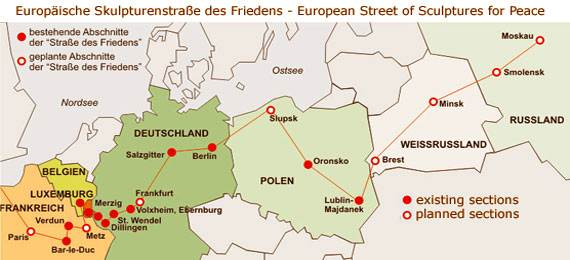


 |





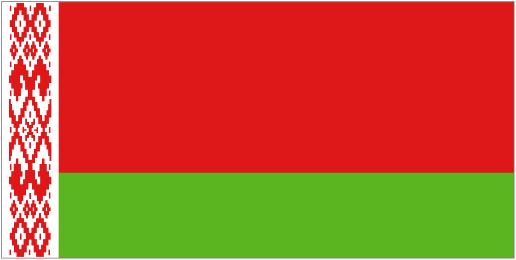
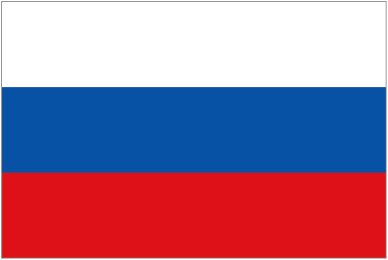 Since 1979 - Strasse des Friedens / Road to Peace, St. Wendel, Saarland (Germany). Conceived in 1920's by Otto Freundlich [1878-1943] - later killed at Majdanek concentration camp - as "Une voie de la Solidarité Humaine et fraternité" from Paris to Moscow. "In 1971, St. Wendel's sculptor Leo Kornbrust initiated the International Sculpture Symposium St. Wendel, now well-known throughout Europe, which brought forth numerous huge stone sculptures by different international artists. In 1979, the sculptures were arranged along 25 kilometers of the Saarland hiking trail from St. Wendel to Lake Bostal."
Sculptures added in 1987 by Paul Schneider. Otto Freundlich Society established in St. Wendel in 2004 to promote the road. /// Click here for Wikipedia article in German. /// Upper right image shows "Wolkenstein" by Franz Xaver Ölzant at St. Wendel. /// "Canadian sculptor Shaukat Chaney proposed Peace Monuments from Canada to Chile (qv) after stumbling across "a series of sculptures spread across 25 kilometres, called the 'road to peace.' Some were on street curbs, some in farmer's fields, others in the middle of forests.
Chaney learned that the project was meant to be just one bead in a string of monuments from Paris to Moscow, and was established in honour of Freundlich who had a vision of two streets, one north-south & one east-west, to promote brotherhood & solidarity. 'I just loved that idea,' said Chaney..." Since 1979 - Strasse des Friedens / Road to Peace, St. Wendel, Saarland (Germany). Conceived in 1920's by Otto Freundlich [1878-1943] - later killed at Majdanek concentration camp - as "Une voie de la Solidarité Humaine et fraternité" from Paris to Moscow. "In 1971, St. Wendel's sculptor Leo Kornbrust initiated the International Sculpture Symposium St. Wendel, now well-known throughout Europe, which brought forth numerous huge stone sculptures by different international artists. In 1979, the sculptures were arranged along 25 kilometers of the Saarland hiking trail from St. Wendel to Lake Bostal."
Sculptures added in 1987 by Paul Schneider. Otto Freundlich Society established in St. Wendel in 2004 to promote the road. /// Click here for Wikipedia article in German. /// Upper right image shows "Wolkenstein" by Franz Xaver Ölzant at St. Wendel. /// "Canadian sculptor Shaukat Chaney proposed Peace Monuments from Canada to Chile (qv) after stumbling across "a series of sculptures spread across 25 kilometres, called the 'road to peace.' Some were on street curbs, some in farmer's fields, others in the middle of forests.
Chaney learned that the project was meant to be just one bead in a string of monuments from Paris to Moscow, and was established in honour of Freundlich who had a vision of two streets, one north-south & one east-west, to promote brotherhood & solidarity. 'I just loved that idea,' said Chaney..."
|

|   Date? - Palme House, 101 Ward Street, Kenyon College, Gambier, Ohio (USA). "Palme House not only has arguably the prettiest porch on campus but is also a top candidate for boasting the most fascinating faculty offices. That’s because members of the Anthropology Department, located here, have covered their walls and filled their shelves with artwork & artifacts from the far-flung places where they do field research. So, meeting with a professor here may whet your appetite to learn more about Botswana, Belize, or Thailand. In Palme House, you’ll also find skeletons in the closet—literally, because the department keeps a teaching collection for coursework in biological anthropology." /// "Palme was graduated from Kenyon in 1948 -- "quite possibly Kenyon's most prominent alumnus on the world stage...
Palme arrived in Gambier from Sweden at age 20 in the autumn of 1947. He was an unconventional student at an unconventional time in the College's history.
“He had wanted to go to school in the States; he never made entirely clear why,” classmate and longtime friend Henry J. Abraham '48 said in a recent interview. “So he turned to his grandfather, who was a Lutheran bishop in Sweden at the time. His grandfather said he would take care of it, but you have to agree to one condition. You have to go to a Protestant college.”
Palme sought a scholarship through the American Scandinavian Foundation. “Suddenly I received a letter from Kenyon,” he told the Alumni Bulletin in a 1984 interview. “I had never heard of the College, but as it turned out I was lucky, extremely lucky to land there.”
He entered Kenyon fluent in English, French, and German, with extensive academic credit from studies in Sweden. He also had served as a cavalry lieutenant." Date? - Palme House, 101 Ward Street, Kenyon College, Gambier, Ohio (USA). "Palme House not only has arguably the prettiest porch on campus but is also a top candidate for boasting the most fascinating faculty offices. That’s because members of the Anthropology Department, located here, have covered their walls and filled their shelves with artwork & artifacts from the far-flung places where they do field research. So, meeting with a professor here may whet your appetite to learn more about Botswana, Belize, or Thailand. In Palme House, you’ll also find skeletons in the closet—literally, because the department keeps a teaching collection for coursework in biological anthropology." /// "Palme was graduated from Kenyon in 1948 -- "quite possibly Kenyon's most prominent alumnus on the world stage...
Palme arrived in Gambier from Sweden at age 20 in the autumn of 1947. He was an unconventional student at an unconventional time in the College's history.
“He had wanted to go to school in the States; he never made entirely clear why,” classmate and longtime friend Henry J. Abraham '48 said in a recent interview. “So he turned to his grandfather, who was a Lutheran bishop in Sweden at the time. His grandfather said he would take care of it, but you have to agree to one condition. You have to go to a Protestant college.”
Palme sought a scholarship through the American Scandinavian Foundation. “Suddenly I received a letter from Kenyon,” he told the Alumni Bulletin in a 1984 interview. “I had never heard of the College, but as it turned out I was lucky, extremely lucky to land there.”
He entered Kenyon fluent in English, French, and German, with extensive academic credit from studies in Sweden. He also had served as a cavalry lieutenant."
|

|  End of 1980 - Kölner Klagemauer/Cologne Wailing Wall, Schildergasse, Koln/Cologne (Germany). In front of the south tower of the Cologne Cathedral. Created (& reactivated in 2004) by Walter Herrmann. Originally consisted of messages denouncing the living conditions of Palestinian people written on small cardboard pieces and suspended on clotheslines. Subsequently addressed other causes. Also called "Wailing Wall for Peace" & "Palestine Wall" after the Wailing Wall in Jerusalem. End of 1980 - Kölner Klagemauer/Cologne Wailing Wall, Schildergasse, Koln/Cologne (Germany). In front of the south tower of the Cologne Cathedral. Created (& reactivated in 2004) by Walter Herrmann. Originally consisted of messages denouncing the living conditions of Palestinian people written on small cardboard pieces and suspended on clotheslines. Subsequently addressed other causes. Also called "Wailing Wall for Peace" & "Palestine Wall" after the Wailing Wall in Jerusalem.
|
 

|  July 20, 1983 - Friedenspark / Peace Park, Leipzig, Zentrum-Südost (Germany). "An open space of about 20 hectares in the centre of [the city], located between the Ostplatz to the north & the Russian Memorial Church (Russische Gedächtniskirche) to the south. The park was opened in 1983, after the secularisation & clearance, under the then East German regime, of the Neuer Johannisfriedhof ("New St. John's Cemetery"), which is what the space formerly was, and its thorough reconstruction." July 20, 1983 - Friedenspark / Peace Park, Leipzig, Zentrum-Südost (Germany). "An open space of about 20 hectares in the centre of [the city], located between the Ostplatz to the north & the Russian Memorial Church (Russische Gedächtniskirche) to the south. The park was opened in 1983, after the secularisation & clearance, under the then East German regime, of the Neuer Johannisfriedhof ("New St. John's Cemetery"), which is what the space formerly was, and its thorough reconstruction."
|
 
 |  Date? - Kölner Friedenspark/Cologne Peace Park, Oberländer Wall, Neustadt-Süd, Köln/Cologne (Germany). "4.5 hectare park in the city are just something special. everything is already overgrown with climbing plants, perfect gepfelgte green spaces and 1,000 corners where you can chill out cozy. Ideal conditions for Kub Viking chess, badminton, Frisbee or bocce. [Google translation]" /// "In honor of John Lennon [1940-1980], who has worked as a pacifist, not only with his music for peace, was inaugurated in December 2012 in Cologne Peace Park on the Upper Wall of the countries paved in mosaic "Imagine Circle." On the occasion of Lennon's birthday be on 9 October, two commemorative plaques at the "Imagine Circle" attached [right image]. One is solely dedicated to John Lennon, the other is provided with the inscription of the song lyrics "Imagine." What should not be missed at such occasion, of course, the music of the Beatles and the 60's in general. [Google translation]" Date? - Kölner Friedenspark/Cologne Peace Park, Oberländer Wall, Neustadt-Süd, Köln/Cologne (Germany). "4.5 hectare park in the city are just something special. everything is already overgrown with climbing plants, perfect gepfelgte green spaces and 1,000 corners where you can chill out cozy. Ideal conditions for Kub Viking chess, badminton, Frisbee or bocce. [Google translation]" /// "In honor of John Lennon [1940-1980], who has worked as a pacifist, not only with his music for peace, was inaugurated in December 2012 in Cologne Peace Park on the Upper Wall of the countries paved in mosaic "Imagine Circle." On the occasion of Lennon's birthday be on 9 October, two commemorative plaques at the "Imagine Circle" attached [right image]. One is solely dedicated to John Lennon, the other is provided with the inscription of the song lyrics "Imagine." What should not be missed at such occasion, of course, the music of the Beatles and the 60's in general. [Google translation]"
|
 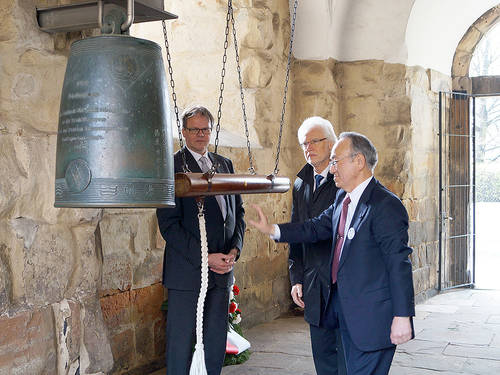

|  1985 - Friedensglocke / Peace Bell, in ruins of Aegidienkirche church, Mitte Quarter, Hannover (Germany). Replica of Hiroshima Peace Bell (qv). Donated by Hannover's partner city Hiroshima (Japan). "Struck at the memorial service for the victims of the atomic bombing of Hiroshima on August 6 every year." [Google translation]. 1985 - Friedensglocke / Peace Bell, in ruins of Aegidienkirche church, Mitte Quarter, Hannover (Germany). Replica of Hiroshima Peace Bell (qv). Donated by Hannover's partner city Hiroshima (Japan). "Struck at the memorial service for the victims of the atomic bombing of Hiroshima on August 6 every year." [Google translation]. 
|

|  March 1, 1991 - Olof-Palme-Platz, Tiergarten, Berlin (Germany).
Date is when previously unnamed square was named for Olof Palme. Image shows Ammonitenbrunnen / Ammonite Fountain by Berlin sculptor Volker Bartsch (built in the center of the square in 1985-1987). March 1, 1991 - Olof-Palme-Platz, Tiergarten, Berlin (Germany).
Date is when previously unnamed square was named for Olof Palme. Image shows Ammonitenbrunnen / Ammonite Fountain by Berlin sculptor Volker Bartsch (built in the center of the square in 1985-1987).
|

|  Date? - Decorated plaque for Olof Palme, Olof-Palme-Platz, Schoppershof, Nürnberg (Germany). Information courtesy of Gerard Lössbroek 28March2016. Click here for list of Olof Palme memorials by Wikipedia. Date? - Decorated plaque for Olof Palme, Olof-Palme-Platz, Schoppershof, Nürnberg (Germany). Information courtesy of Gerard Lössbroek 28March2016. Click here for list of Olof Palme memorials by Wikipedia.
|



|  1985 - Friedens-Glocke / Japanese Peace Bell, Aegidienkirche, Hannover (Germany). "A special relationship connects the Aegidienkirche with Hiroshima. Hanover's Japanese sister city in 1985 gave a peace bell. An identical twin hanging in Hiroshima. There, as the ground floor of the ruined tower, the bells are the same time every year on 6 August struck in commemoration of the first atomic bomb on Hiroshima and the victims of war and violence. [Google translation]." /// "The Aegidienkirche is one of the ancient churches in Hannover. It was bombed severely during World War II, and now only the walls are standing." 1985 - Friedens-Glocke / Japanese Peace Bell, Aegidienkirche, Hannover (Germany). "A special relationship connects the Aegidienkirche with Hiroshima. Hanover's Japanese sister city in 1985 gave a peace bell. An identical twin hanging in Hiroshima. There, as the ground floor of the ruined tower, the bells are the same time every year on 6 August struck in commemoration of the first atomic bomb on Hiroshima and the victims of war and violence. [Google translation]." /// "The Aegidienkirche is one of the ancient churches in Hannover. It was bombed severely during World War II, and now only the walls are standing."
|

| 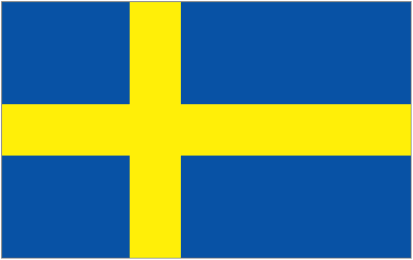 1986 - Memorial plaque at the place of Olof Palme's murder at Tunnelgatan–Sveavägen in Stockholm (Sweden). Inscription: "On this site, Prime Minister of Sweden, Olof Palme, was murdered on 28 February 1986."
Click here for list of Olof Palme memorials by Wikipedia. 1986 - Memorial plaque at the place of Olof Palme's murder at Tunnelgatan–Sveavägen in Stockholm (Sweden). Inscription: "On this site, Prime Minister of Sweden, Olof Palme, was murdered on 28 February 1986."
Click here for list of Olof Palme memorials by Wikipedia.
|

|  Date? - Mahnmal für den Frieden / Peace Memorial, Hauptmannsgrün, Saxony (Germany). Built when & by whom? Date? - Mahnmal für den Frieden / Peace Memorial, Hauptmannsgrün, Saxony (Germany). Built when & by whom?
|

| D E N K M A L
 1986 - Gegendenkmal (Antikriegsdenkmal / Anti-War Memorial), Stephansplatz, Hamburg (Germany). "For world peace, disarmament, and civil conflicts." By Austrian artist Alfred Hrdlicka [1928-2009]. "Grotesquely mangled corpses & emaciated prisoners. A critique of an older monument next to it--a hideous block, like a massive bunker, erected in 1936 in honor of tont... A mahnmal used as argument." [Ian Buruma (1994), "The Wages of Guilt," p. 234.] 1986 - Gegendenkmal (Antikriegsdenkmal / Anti-War Memorial), Stephansplatz, Hamburg (Germany). "For world peace, disarmament, and civil conflicts." By Austrian artist Alfred Hrdlicka [1928-2009]. "Grotesquely mangled corpses & emaciated prisoners. A critique of an older monument next to it--a hideous block, like a massive bunker, erected in 1936 in honor of tont... A mahnmal used as argument." [Ian Buruma (1994), "The Wages of Guilt," p. 234.]
|


| M A H N M A L
 October 10, 1986-November 10, 1993 - "Mahnmal gegen Faschismus, Krieg, Gewalt - Fur Frieden und Menschenrechte / Memorial Against Fascism, War and Violence - For Peace and Human Rights," Rathaus Train Station, Harburger Ring, Hamburg (Germany). By Esther Shalev-Gerz & Jochen Gerz. "Started out as a pillar [12 meter stele] in 1986 and was gradually lowered into the ground over eight [or ten?] steps until 1993. Since then it has just been a plaque in the ground." Text on plaque quoted differently by different sources: "Denn nichts kann auf Dauer an unserer Stelle sich gegen das Unrecht erheben / Because nothing can permanently at our place to rise against injustice." "We invite the citizens of Harburg and visitors to the town to add their names here to ours. In doing so we commit ourselves to remain vigilant. As more and more names cover the 12-meter-tall lead column, it will gradually be lowered into the ground. One day it will have disappeared completely and the site of the Harburg monument against fascism will be empty. In the end it is only we ourselves who can rise up against injustice." October 10, 1986-November 10, 1993 - "Mahnmal gegen Faschismus, Krieg, Gewalt - Fur Frieden und Menschenrechte / Memorial Against Fascism, War and Violence - For Peace and Human Rights," Rathaus Train Station, Harburger Ring, Hamburg (Germany). By Esther Shalev-Gerz & Jochen Gerz. "Started out as a pillar [12 meter stele] in 1986 and was gradually lowered into the ground over eight [or ten?] steps until 1993. Since then it has just been a plaque in the ground." Text on plaque quoted differently by different sources: "Denn nichts kann auf Dauer an unserer Stelle sich gegen das Unrecht erheben / Because nothing can permanently at our place to rise against injustice." "We invite the citizens of Harburg and visitors to the town to add their names here to ours. In doing so we commit ourselves to remain vigilant. As more and more names cover the 12-meter-tall lead column, it will gradually be lowered into the ground. One day it will have disappeared completely and the site of the Harburg monument against fascism will be empty. In the end it is only we ourselves who can rise up against injustice."
|
![]()

| D E N K M A L
 October 1986 -
Denkmal für den unbekannten Deserteur / Monument to the Unknown Deserter, Gustav-Heinemann Büergerhaus, Bremen-Vegesack, Bremen (Germany).
"A one meter high pedestal [and] a sculpture of a soldier's head, covered with a helmet
and camouflage net. The inscription reads, 'For the unknown deserter'. The
memorial was commissioned by a group called 'Gruppe Reservisten verweigern sich' / 'Group of resisting reservists.'" Gustav Heinemann [1899-1976] "was German Minister of Interior Affairs from 1949 to 1950, Minister of Justice from 1966 to 1969, and President of the Federal Republic of Germany from 1969 to 1974. He was famous for being open-minded with respect to the student protests of 1968, and he tried to keep his office as down-to-earth as possible.
In the Weimar Republic, Heinemann was member of the Christian Social People's Service (CSVD). After World War II he was one of the founders of the CDU and became mayor of the city of Essen. He was Minister of the Interior in the first cabinet of Konrad Adenauer. He left the cabinet in 1950 and the CDU in 1952 to form the All-German People's Party (GVP) with Helene Wessel and other CDU and Center Party members. In 1957 he, and most GVP members, joined the SPD. In the grand coalition (1966-69) he was Minister of Justice. In 1969 he became the first SPD member to be elected President of Germany since the death of Reichspräsident Friedrich Ebert (president since 1919) in 1925. The Gustav-Heinemann-Friedenspreis für Kinder- und Jugendbücher / Gustav Heinemann Peace Prize for Children's and Youth Books is awarded every year for a book judged to have best promoted the cause of world peace." October 1986 -
Denkmal für den unbekannten Deserteur / Monument to the Unknown Deserter, Gustav-Heinemann Büergerhaus, Bremen-Vegesack, Bremen (Germany).
"A one meter high pedestal [and] a sculpture of a soldier's head, covered with a helmet
and camouflage net. The inscription reads, 'For the unknown deserter'. The
memorial was commissioned by a group called 'Gruppe Reservisten verweigern sich' / 'Group of resisting reservists.'" Gustav Heinemann [1899-1976] "was German Minister of Interior Affairs from 1949 to 1950, Minister of Justice from 1966 to 1969, and President of the Federal Republic of Germany from 1969 to 1974. He was famous for being open-minded with respect to the student protests of 1968, and he tried to keep his office as down-to-earth as possible.
In the Weimar Republic, Heinemann was member of the Christian Social People's Service (CSVD). After World War II he was one of the founders of the CDU and became mayor of the city of Essen. He was Minister of the Interior in the first cabinet of Konrad Adenauer. He left the cabinet in 1950 and the CDU in 1952 to form the All-German People's Party (GVP) with Helene Wessel and other CDU and Center Party members. In 1957 he, and most GVP members, joined the SPD. In the grand coalition (1966-69) he was Minister of Justice. In 1969 he became the first SPD member to be elected President of Germany since the death of Reichspräsident Friedrich Ebert (president since 1919) in 1925. The Gustav-Heinemann-Friedenspreis für Kinder- und Jugendbücher / Gustav Heinemann Peace Prize for Children's and Youth Books is awarded every year for a book judged to have best promoted the cause of world peace."
|


 |
 May 4, 1987 - Memorial Fountain, at "Anna B. Eckstein plant," Coburg (Germany). In the "Anna B. Eckstein system" between Moor Street & the Mühlgasse Walk. "In 1985 the fountain was erected in a park in 1985 & named for Anna Bernardine Eckstein [1868-1947] on 4 May 1987... By Coburg sculptor Egon Ruggaber, cost 9300 DM, consists of a round stone column with a top-mounted small, shallow pool of water.
The teacher & pacifist, was born in 1868 in Coburg, traveled in 1884 to the USA, returned around 1910 & died in 1947 in Coburg."
/// Eckstein "was the daughter of a German officer. She left Germany in 1886 (?) for America, where she became a naturalized American citizen & joined the Boston Peace Society. She became a school teacher & later the principal of the School of Modern Languages in Boston. At the age of 16, Eckstein learned [sic] to know the Baroness Bertha von Suttner [1843-1914], who interested her in the cause of peace. Eckstein became an ardent champion of world peace, going on many world tours to promote this ideal. Eckstein was a vice-president of the American Peace Society from 1905 to 1911. She took an active role in the 2nd National Peace Congress, held in Chicago May 2-5, 1909. Edwin Ginn [1838-1914] sponsored her after she left the School of Modern Languages in order to engage wholly in peace work.
Eckstein saw as her greatest work the collection of signatures for 'The World Petition to Prevent War Between Nations,' to be signed by heads of the 44 signatory powers of the Hague Conventions. She presented the first version of the petition in 1907 to the 2nd Hague Conference with some 2 million signatures. She had some 6 million signatures [on a petition for the 3rd Hague Conference] when her efforts were ended by the advent of WW-I. During the Nazi regime, she was curbed in her peace activities. After her death, her papers & books were donated to the Swarthmore College Peace Collection by her nephew in exchange for CARE food parcels." Info courtesy of Gerard Lössbroek. May 4, 1987 - Memorial Fountain, at "Anna B. Eckstein plant," Coburg (Germany). In the "Anna B. Eckstein system" between Moor Street & the Mühlgasse Walk. "In 1985 the fountain was erected in a park in 1985 & named for Anna Bernardine Eckstein [1868-1947] on 4 May 1987... By Coburg sculptor Egon Ruggaber, cost 9300 DM, consists of a round stone column with a top-mounted small, shallow pool of water.
The teacher & pacifist, was born in 1868 in Coburg, traveled in 1884 to the USA, returned around 1910 & died in 1947 in Coburg."
/// Eckstein "was the daughter of a German officer. She left Germany in 1886 (?) for America, where she became a naturalized American citizen & joined the Boston Peace Society. She became a school teacher & later the principal of the School of Modern Languages in Boston. At the age of 16, Eckstein learned [sic] to know the Baroness Bertha von Suttner [1843-1914], who interested her in the cause of peace. Eckstein became an ardent champion of world peace, going on many world tours to promote this ideal. Eckstein was a vice-president of the American Peace Society from 1905 to 1911. She took an active role in the 2nd National Peace Congress, held in Chicago May 2-5, 1909. Edwin Ginn [1838-1914] sponsored her after she left the School of Modern Languages in order to engage wholly in peace work.
Eckstein saw as her greatest work the collection of signatures for 'The World Petition to Prevent War Between Nations,' to be signed by heads of the 44 signatory powers of the Hague Conventions. She presented the first version of the petition in 1907 to the 2nd Hague Conference with some 2 million signatures. She had some 6 million signatures [on a petition for the 3rd Hague Conference] when her efforts were ended by the advent of WW-I. During the Nazi regime, she was curbed in her peace activities. After her death, her papers & books were donated to the Swarthmore College Peace Collection by her nephew in exchange for CARE food parcels." Info courtesy of Gerard Lössbroek. 
|  September 12, 2013 - Anna-B.-Eckstein-Schule (Grundschule) / Anna-B.-Eckstein Elementary School, Schulstraße 18, Meeder, Coburg (Germany). "Since 09.12.2013 our school bears the name of Anna Bernhardine Eckstein [1868-1947], a teacher, head teacher and activist for peace, was born in 1868 in Coburg and died there in 1947... In the basement of our school is 'Lernwerkstaff Frieden / Peace Learning Workshop' of the Friedensmuseum Meeder / Meeder Peace Museum [Google translation]." Info courtesy of Gerard Lössbroek. September 12, 2013 - Anna-B.-Eckstein-Schule (Grundschule) / Anna-B.-Eckstein Elementary School, Schulstraße 18, Meeder, Coburg (Germany). "Since 09.12.2013 our school bears the name of Anna Bernhardine Eckstein [1868-1947], a teacher, head teacher and activist for peace, was born in 1868 in Coburg and died there in 1947... In the basement of our school is 'Lernwerkstaff Frieden / Peace Learning Workshop' of the Friedensmuseum Meeder / Meeder Peace Museum [Google translation]." Info courtesy of Gerard Lössbroek.
|
![]()

| D E N K M A L
 May 7, 1987 -
Denkmal für den unbekannten Deserteur / Monument to the Unknown Deserter, Fuldaaaue, Kassel (Germany). "Near a memorial for the fallen of both world wars. Has the following inscription: 'In memory of the Kassel soldiers, who refused military service for the national-socialist
violent dictatorship, and who were persecuted and killed as a result.' A decision for such a memorial had been made by the city's
governing council on 4th February." Click here for "Erinnerung braucht einen Ort
Zum Kasseler 'Mahnmal für die Opfer des Faschismus' von Hilde Dohmann." Click here for an overview of deserters monument initiatives in Germany (From Zeitschrift OHNE UNS - Zeitschrift zur Totalen Kriegsdienstverweigerung, Ausgabe 1/94, Februar 1994). May 7, 1987 -
Denkmal für den unbekannten Deserteur / Monument to the Unknown Deserter, Fuldaaaue, Kassel (Germany). "Near a memorial for the fallen of both world wars. Has the following inscription: 'In memory of the Kassel soldiers, who refused military service for the national-socialist
violent dictatorship, and who were persecuted and killed as a result.' A decision for such a memorial had been made by the city's
governing council on 4th February." Click here for "Erinnerung braucht einen Ort
Zum Kasseler 'Mahnmal für die Opfer des Faschismus' von Hilde Dohmann." Click here for an overview of deserters monument initiatives in Germany (From Zeitschrift OHNE UNS - Zeitschrift zur Totalen Kriegsdienstverweigerung, Ausgabe 1/94, Februar 1994).
|



| P
L
A
Q
U
E |  August 1987 - A plaque for Michael Lerpscher, at the catholic church, Missen-Wilhams, Sonthofen district, Bravaria (Germany). This is the home community of Michael Lerpscher [1905-1940] who was a religiously motivated conscientious objector executed by the Nazis. Inscribed in German: "Laienbrüder der Christkönigsgesellschaft - Märtyrer für den Frieden Christi [Pax Christi]." August 1987 - A plaque for Michael Lerpscher, at the catholic church, Missen-Wilhams, Sonthofen district, Bravaria (Germany). This is the home community of Michael Lerpscher [1905-1940] who was a religiously motivated conscientious objector executed by the Nazis. Inscribed in German: "Laienbrüder der Christkönigsgesellschaft - Märtyrer für den Frieden Christi [Pax Christi]."
|
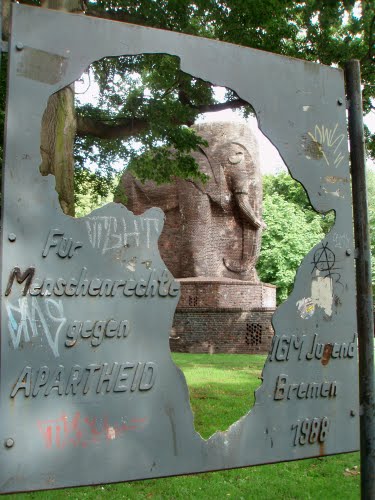
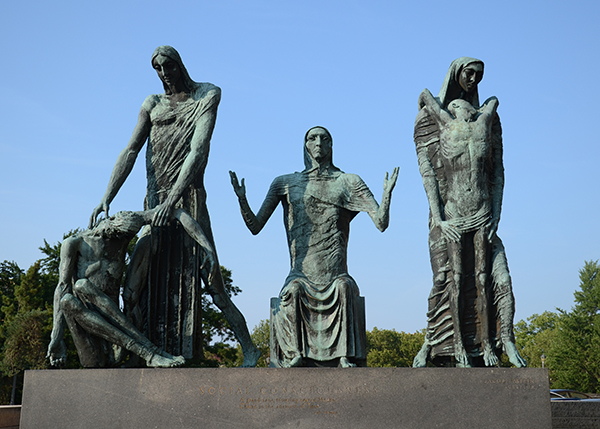
|  1988-1990-2009 - Reichs[anti]kolonialehrendenkmal, Bremen (Germany). "This ten-meter high structure was completed in 1931 as a monument to the German colonies which then included Cameroon, Togo, Deutsch-Ostafrika [Tanzania], Deutsch-Südwestafrika [Namibia] & several islands. For decades the Reichskolonialehrendenkmal / ______ stood as a powerful symbol of German colonial ambition. The allied forces chiseled off the inscriptions on the outside, but the plaques on the inside of “der elefant” remained, including a list of 1,400 colonial soldiers & officials who died defending the German empire. In 1988, a metal sign was created next to the elephant by the youth wing of the Bremen metal workers union in support of the Anti-Apartheid movement. In 1990, with the celebration of Namibian independence from South Africa, the elephant itself was re-dedicated as the “Bremen anti colonial monument” thereby attempting to invert its historical meaning yet retaining the original design. And in 2009 a new monument was created next to the elephant to the victims of German genocide. /// This is "Monday's Monument" #69. 1988-1990-2009 - Reichs[anti]kolonialehrendenkmal, Bremen (Germany). "This ten-meter high structure was completed in 1931 as a monument to the German colonies which then included Cameroon, Togo, Deutsch-Ostafrika [Tanzania], Deutsch-Südwestafrika [Namibia] & several islands. For decades the Reichskolonialehrendenkmal / ______ stood as a powerful symbol of German colonial ambition. The allied forces chiseled off the inscriptions on the outside, but the plaques on the inside of “der elefant” remained, including a list of 1,400 colonial soldiers & officials who died defending the German empire. In 1988, a metal sign was created next to the elephant by the youth wing of the Bremen metal workers union in support of the Anti-Apartheid movement. In 1990, with the celebration of Namibian independence from South Africa, the elephant itself was re-dedicated as the “Bremen anti colonial monument” thereby attempting to invert its historical meaning yet retaining the original design. And in 2009 a new monument was created next to the elephant to the victims of German genocide. /// This is "Monday's Monument" #69.
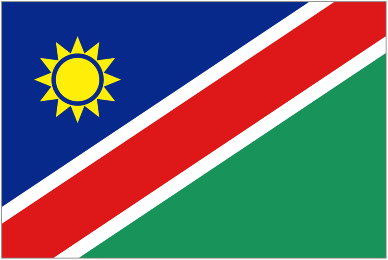
|

| D E N K M A L
 1988 -
Denkmal für den unbekannten Deserteur / Monument to the Unknown Deserter, Trammplatz, Hannover (Germany). "Since 1988 there has been at Trammplatz in front of the New Town Hall in Hanover, a memorial to deserters. It is located on the edge of the square on the wall to the cycle. About the victim group of deserters little is known. About a dozen of them were buried in the former garrison cemetery, the Fössefeldfriedhof in Linden (Cemetery Road). Deserters were shot in Vahrenheide in the ball catching drift on the barracks. [Google translation]" Info courtesy of Gerard Lössbroek. 1988 -
Denkmal für den unbekannten Deserteur / Monument to the Unknown Deserter, Trammplatz, Hannover (Germany). "Since 1988 there has been at Trammplatz in front of the New Town Hall in Hanover, a memorial to deserters. It is located on the edge of the square on the wall to the cycle. About the victim group of deserters little is known. About a dozen of them were buried in the former garrison cemetery, the Fössefeldfriedhof in Linden (Cemetery Road). Deserters were shot in Vahrenheide in the ball catching drift on the barracks. [Google translation]" Info courtesy of Gerard Lössbroek.
|
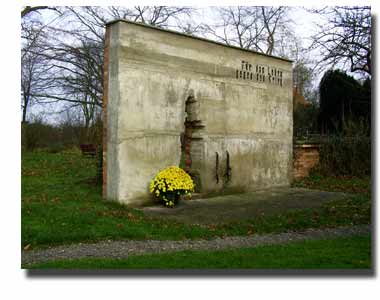
| D E N K M A L
 Date? - Deserteur Denkmal / Deserter Monument, Sievershausen (Germany). Date? - Deserteur Denkmal / Deserter Monument, Sievershausen (Germany).
|
 .jpg)

| S C U L P T U R E
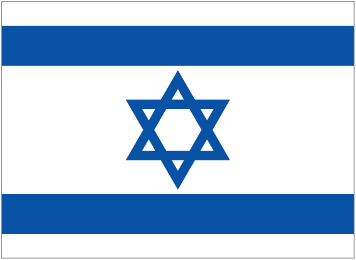 1990 - "In Memory of the Death March from Dachau," Yad Vashem, Jerusalem (Israel). By Hubertus Von Pilgrim. From plaque: "Gift of the City of Gauting, Germany. On the 26th of April 1945, 7000 prisoners were forced on a death march. Only a few survived. Eight identical sculptures were placed in villages where the victims passed. The ninth was erected in their memory here at Yad Vashem, Jerusalem." Note the Dachau Memorial in background of right image. Image at far right is Denkmal für die Todesmärsche in Fürstenfeldbruck, Bravaria (Germany). 1990 - "In Memory of the Death March from Dachau," Yad Vashem, Jerusalem (Israel). By Hubertus Von Pilgrim. From plaque: "Gift of the City of Gauting, Germany. On the 26th of April 1945, 7000 prisoners were forced on a death march. Only a few survived. Eight identical sculptures were placed in villages where the victims passed. The ninth was erected in their memory here at Yad Vashem, Jerusalem." Note the Dachau Memorial in background of right image. Image at far right is Denkmal für die Todesmärsche in Fürstenfeldbruck, Bravaria (Germany).  | 
|

| P
L
A
Q
U
E |  October 31, 1990 - Plaque for Michael Lerpscher & Josef Ruf, St. Ulrich Catholic Church, Graz (Germany). Michael Lerpscher [1905-1940] and Josef Ruf [1905-1940] were both religiously motivated conscientious objectors executed by the Nazis.
Inscribed in German: "Laienbrüder der Christkönigsgesellschaft - Märtyrer für den Frieden Christi [Pax Christi]." October 31, 1990 - Plaque for Michael Lerpscher & Josef Ruf, St. Ulrich Catholic Church, Graz (Germany). Michael Lerpscher [1905-1940] and Josef Ruf [1905-1940] were both religiously motivated conscientious objectors executed by the Nazis.
Inscribed in German: "Laienbrüder der Christkönigsgesellschaft - Märtyrer für den Frieden Christi [Pax Christi]."
|



|  November 14, 1990 - Fridenszeichen / Peace Monument, Lake Konstance (Bodensee), Lindau, Bravaria (Germany). According to Peter van den Dungen, "Very near to where the Friedensmuseum Landau (Friedens Raeume / Peace Rooms) is located. Sculpted by Dietrich Foerster, the winner of a competition organised by the Akademie der Bildenden Kuenste in Munich. A bronze plaque explains that it was unveiled on the 50th anniversary of the bombing of Coventry cathedral, and concludes with "Dona Nobis Pacem." November 14, 1990 - Fridenszeichen / Peace Monument, Lake Konstance (Bodensee), Lindau, Bravaria (Germany). According to Peter van den Dungen, "Very near to where the Friedensmuseum Landau (Friedens Raeume / Peace Rooms) is located. Sculpted by Dietrich Foerster, the winner of a competition organised by the Akademie der Bildenden Kuenste in Munich. A bronze plaque explains that it was unveiled on the 50th anniversary of the bombing of Coventry cathedral, and concludes with "Dona Nobis Pacem." 
|


 | S C H O O L & S T A T U E
 Date? - Anne-Frank-Schule
Haupt- und Realschule mit Ganztagsangebot,
Am Stadtforst 21.
49716, Emsland District, Lower Saxony, Meppen (Germany). Date? - Anne-Frank-Schule
Haupt- und Realschule mit Ganztagsangebot,
Am Stadtforst 21.
49716, Emsland District, Lower Saxony, Meppen (Germany).
|

| M
E
M |  Date? - Memorial Stone, Aachen (Germany). At the location of the former home of Anne Frank during her stay in Aachen. Date? - Memorial Stone, Aachen (Germany). At the location of the former home of Anne Frank during her stay in Aachen.
|
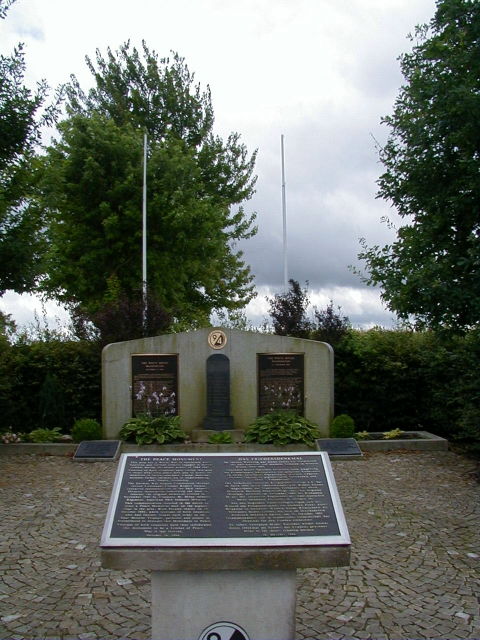
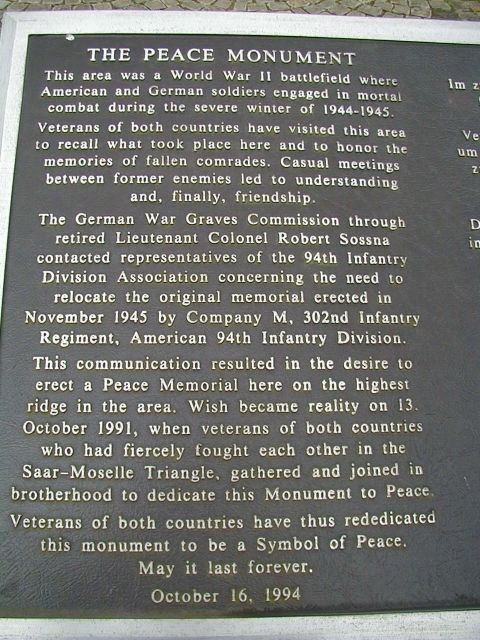

| D E N K M A L
 October 13, 1991 - Friedensdenkmal / Peace Monument, Taben-Rodt (Germany). German War Graves Commission and the US 94th Infantry Division Association. Duplicate plaques in German and English. Rededicated October 16, 1994. October 13, 1991 - Friedensdenkmal / Peace Monument, Taben-Rodt (Germany). German War Graves Commission and the US 94th Infantry Division Association. Duplicate plaques in German and English. Rededicated October 16, 1994. 
|


| S
T
O
N
E |  1992 -
Memorial stone for Josef Ruf, next to the Maria Geburt / Mary's Birth Catholic Church, Hochberg, Bad Saulgau-Hochberg, Sigmaringen district (Germany). Placed by Pax Christi. Born in Hochberg (now part of the city of Bad Saulgau), Josef Ruf [1905-1940] was a religiously motivated conscientious objector executed by the Nazis. German inscription says, "Lived for peace, died by violence." 1992 -
Memorial stone for Josef Ruf, next to the Maria Geburt / Mary's Birth Catholic Church, Hochberg, Bad Saulgau-Hochberg, Sigmaringen district (Germany). Placed by Pax Christi. Born in Hochberg (now part of the city of Bad Saulgau), Josef Ruf [1905-1940] was a religiously motivated conscientious objector executed by the Nazis. German inscription says, "Lived for peace, died by violence."
|


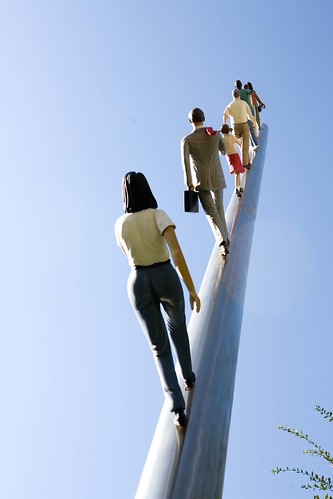


|     1992-2008 - "Walking to the Sky." (#1) 1992 "Man Walking to the Sky," Kassel (Germany). (#2) "Woman Waking to the Sky," Strasbourg (France). (#3) 2004 "Humanity Walking to the Sky," moved from Rockefeller Center, New York City, & Nasher Collection, Dallas, Texas. 2006 Carnegie-Mellon University, Warner Hall, Forbes Avenue, Pittsburgh, Pensylvania (USA). (#4) 2008 Kiturami Homsys Company, Hwagok-dong, Gangseo-gu, Seoul/Yonhap (South Korea). Sculptures by American Jonathan Borofsky. The sculpture in Seoul features people of different ages and ethnicities, including three Asian people. The pole is angled at 75 degrees, because "the idea is to walk to the sky, not to the building across the street,'' Borofsky joked. 1992-2008 - "Walking to the Sky." (#1) 1992 "Man Walking to the Sky," Kassel (Germany). (#2) "Woman Waking to the Sky," Strasbourg (France). (#3) 2004 "Humanity Walking to the Sky," moved from Rockefeller Center, New York City, & Nasher Collection, Dallas, Texas. 2006 Carnegie-Mellon University, Warner Hall, Forbes Avenue, Pittsburgh, Pensylvania (USA). (#4) 2008 Kiturami Homsys Company, Hwagok-dong, Gangseo-gu, Seoul/Yonhap (South Korea). Sculptures by American Jonathan Borofsky. The sculpture in Seoul features people of different ages and ethnicities, including three Asian people. The pole is angled at 75 degrees, because "the idea is to walk to the sky, not to the building across the street,'' Borofsky joked.
|



|  December 16, 1992 - Stolperstein, Rathaus / City Hall, Cologne (Germany). First Stolperstein -- 10-cm x 10-cm brass marker set among paving stones to identify the last home of a Holocaust victim. This practice was started & is continued by Gunther Demnig (right image). December 16, 1992 - Stolperstein, Rathaus / City Hall, Cologne (Germany). First Stolperstein -- 10-cm x 10-cm brass marker set among paving stones to identify the last home of a Holocaust victim. This practice was started & is continued by Gunther Demnig (right image).
|
 | Typical Stolperstein. Translation: "Here lived Ida Arensberg. née Benjamin *1870 - deported 1942. Murdered in Theresienstadt on 18.9.1942." As of January 11, 2015, there were 50,000 Stolpersteine in 21 countries of Western Europe: Germany, Austria,
Netherlands, Hungary, Poland, Czech Republic, Belgium, Ukraine,
Italy, Norway, Slovakia, Slovenia, France, Croatia, Luxemburg, Russia, Switzerland,
Greece, Spain, Belarus & Lithuania. According to Wikipedia, "the stolperstein project [is] the world's largest decentralized memorial."
|



| M A H N M A L
  1993 - Mahnmal gegen Rassismus / Monument against Racism, Schlossplatz, Saarbrüken, Saarland (Germany). Also called "Invisible Warning Monument." "Designed by Jochen Gerz in collaboration with students of the College of Fine Arts. On the [invisible] back of 2,146 paving stones the names of Jewish cemeteries are engraved, which existed before the Second World War in Germany." Outside the castle which used to contain a Gestapo prison. [Ian Buruma (1994), "The Wages of Guilt," p. 205.]
1993 - Mahnmal gegen Rassismus / Monument against Racism, Schlossplatz, Saarbrüken, Saarland (Germany). Also called "Invisible Warning Monument." "Designed by Jochen Gerz in collaboration with students of the College of Fine Arts. On the [invisible] back of 2,146 paving stones the names of Jewish cemeteries are engraved, which existed before the Second World War in Germany." Outside the castle which used to contain a Gestapo prison. [Ian Buruma (1994), "The Wages of Guilt," p. 205.] 
|



| S
T
R
E
E
T |  October 24, 1993 - Straße der Menschenrechte / Way of Human Rights, Germanisches Nationalmuseum /German National Museum, Nuremberg (Germany). "Sited on the street between the new and old buildings of the musuem, connecting Kornmarkt Street and the medieval city wall. Consists of a gate, 27 round pillars made of white concrete, two pillars buried in the ground showing only a round plate, and one columnar oak, for a total of 30 pillars. Engraved in each pillar is one article of the Universal Declaration of Human Rights. "Part of Nuremberg's efforts to shake off its Nazi-era reputation as the 'City of the Party Rallies' and reinvent itself as a 'City of Peace & Human Rights.'" "By Israeli sculptor Danny Karavan. See similar use of stone pillars by Karavan at Nitzana Settlement in the Negev Desert (Israel). October 24, 1993 - Straße der Menschenrechte / Way of Human Rights, Germanisches Nationalmuseum /German National Museum, Nuremberg (Germany). "Sited on the street between the new and old buildings of the musuem, connecting Kornmarkt Street and the medieval city wall. Consists of a gate, 27 round pillars made of white concrete, two pillars buried in the ground showing only a round plate, and one columnar oak, for a total of 30 pillars. Engraved in each pillar is one article of the Universal Declaration of Human Rights. "Part of Nuremberg's efforts to shake off its Nazi-era reputation as the 'City of the Party Rallies' and reinvent itself as a 'City of Peace & Human Rights.'" "By Israeli sculptor Danny Karavan. See similar use of stone pillars by Karavan at Nitzana Settlement in the Negev Desert (Israel).
|


|  September 2, 1995, - "Friedensdenkmal Kleeblatt / Cloverleaf Peace monument, Basdorf, District of Rheinsberg (Germany). Inscription: "For peace, the people of the 21st century." Established by the citizens' initiative "Freie Heide" was a replica of the peace monument from the kilometer 72 of the Moscow-Minsk Highway. Inaugurated on the 50th anniversary of the end of the Second World War, at which the German tanks reversed in 1941." One of 15 peace monuments found in July 2017 by Googling "Friedensdenkmal" or "Friedensmahnmal." September 2, 1995, - "Friedensdenkmal Kleeblatt / Cloverleaf Peace monument, Basdorf, District of Rheinsberg (Germany). Inscription: "For peace, the people of the 21st century." Established by the citizens' initiative "Freie Heide" was a replica of the peace monument from the kilometer 72 of the Moscow-Minsk Highway. Inaugurated on the 50th anniversary of the end of the Second World War, at which the German tanks reversed in 1941." One of 15 peace monuments found in July 2017 by Googling "Friedensdenkmal" or "Friedensmahnmal."
|



|  Date? -
Denkmal für den Weltfrieden / Monument for World Peace, Platz des Friedens, on Achalm [Mountain], Reutlingen, Baden-Württemberg (Germany).
Ein Denkmal für den Weltfrieden auf der Achalm. "Peace monument on the square of peace on the Achalm. A monument to world peace on the Achalm." /// "In the Name of Peace.
'The flame of peace /
A symbol of global peace /
In memory of our mission /
To work for peace /
In thought, words, and deeds."
/// "The Flame of Peace / Flamme des Friedens is an award granted by the Austrian non-profit organization Vereins zur Förderung des Friedens / Association for the Promotion of Peace, which promotes world peace. The flame is represented by a wood carving mounted on a stone base. The organization gives out awards to prominent people, peace activists & organizations for their activity in promoting peace. ///
Her Imperial Royal Highness Princess Herta Margarete of Hapsburg-Lorraine, Archduke of Austria, Princess of Tuscany, Princess of Hungary, Princess of Bohemia, Princess of Croatia, President of the Flame of Peace [Google translation]." /// "Sample Monuments" erected at Schloss Wilhelminenberg in Vienna (Austria), March 2009; Sana'a (Yemen), September 2009; Mitterdorf (Austria), March 14, 2012; and Ernstbrunn (Austria), May 26, 2012. Date? -
Denkmal für den Weltfrieden / Monument for World Peace, Platz des Friedens, on Achalm [Mountain], Reutlingen, Baden-Württemberg (Germany).
Ein Denkmal für den Weltfrieden auf der Achalm. "Peace monument on the square of peace on the Achalm. A monument to world peace on the Achalm." /// "In the Name of Peace.
'The flame of peace /
A symbol of global peace /
In memory of our mission /
To work for peace /
In thought, words, and deeds."
/// "The Flame of Peace / Flamme des Friedens is an award granted by the Austrian non-profit organization Vereins zur Förderung des Friedens / Association for the Promotion of Peace, which promotes world peace. The flame is represented by a wood carving mounted on a stone base. The organization gives out awards to prominent people, peace activists & organizations for their activity in promoting peace. ///
Her Imperial Royal Highness Princess Herta Margarete of Hapsburg-Lorraine, Archduke of Austria, Princess of Tuscany, Princess of Hungary, Princess of Bohemia, Princess of Croatia, President of the Flame of Peace [Google translation]." /// "Sample Monuments" erected at Schloss Wilhelminenberg in Vienna (Austria), March 2009; Sana'a (Yemen), September 2009; Mitterdorf (Austria), March 14, 2012; and Ernstbrunn (Austria), May 26, 2012.  One of 15 peace monuments found in July 2017 by Googling "Friedensdenkmal" or "Friedensmahnmal." FLAMES One of 15 peace monuments found in July 2017 by Googling "Friedensdenkmal" or "Friedensmahnmal." FLAMES
|


|  Date? - Peace Monument, Mölln, Schleswig-Holstein (Germany). "A monument made of paper. This material behaves like the memory itself: it fades, it is fragile and unsafe. In addition, it is the material of war: War declarations, convocations, orders, death news and peace treaties were also written on paper, lost lists or historical treatises." /// "Warriors' memorials for the fallen soldiers of the two world wars have been responsible for cemeteries, church and local places for many decades. They are usually monoliths, stone or metal, which appear to be symbolic for the war and the warrior. New monuments are extremely rare, but for many, the heroic worship of the ancient monuments has to be maintained. But war is not a hero, and the reason why so many, often very young, men were killed for their lives is not addressed. In Molln the step was dared and a new monument for the fallen soldiers of both world wars was conceived. In the foreground is not the warrior, but the man who was torn from his life. As a symbol for the war is not metal or stone, but paper. For paper is the material which made the war possible at that time. Plans, orders, conscripts, death reports, even the work-up, are unthinkable without paper. In addition, paper behaves like the memory itself: it must be preserved, protected and cultivated in order to endure the times. ///
The monument consists of a glass cuboid, in which is again a glass-enclosed cuboid of DIN-A4 paper stack. The dimensions of this cuboid correspond to those of the old Mollner warrior monument. It consists of half a million arcs, stacked as in an archive. The upper layer is to be seen as a map of Molln, the basis of which are the names of the fallen soldiers of both world wars. They are at the place where these people have lived last, or were born. From the impersonal list-name, a relation to this man and to his homeland is established. The monument can thus also be seen as a kind of glass archeology in which the memory of these people is preserved and a more intensive employment is possible. The recognition of the fatal consequences of war and terror with this monument is possible for all people and all age groups In addition to its function of memory and knowledge, the message of the importance of peace. Therefore the name for the new monument is also 'Peace Monument.'" One of 15 peace monuments found in July 2017 by Googling "Friedensdenkmal" or "Friedensmahnmal." Date? - Peace Monument, Mölln, Schleswig-Holstein (Germany). "A monument made of paper. This material behaves like the memory itself: it fades, it is fragile and unsafe. In addition, it is the material of war: War declarations, convocations, orders, death news and peace treaties were also written on paper, lost lists or historical treatises." /// "Warriors' memorials for the fallen soldiers of the two world wars have been responsible for cemeteries, church and local places for many decades. They are usually monoliths, stone or metal, which appear to be symbolic for the war and the warrior. New monuments are extremely rare, but for many, the heroic worship of the ancient monuments has to be maintained. But war is not a hero, and the reason why so many, often very young, men were killed for their lives is not addressed. In Molln the step was dared and a new monument for the fallen soldiers of both world wars was conceived. In the foreground is not the warrior, but the man who was torn from his life. As a symbol for the war is not metal or stone, but paper. For paper is the material which made the war possible at that time. Plans, orders, conscripts, death reports, even the work-up, are unthinkable without paper. In addition, paper behaves like the memory itself: it must be preserved, protected and cultivated in order to endure the times. ///
The monument consists of a glass cuboid, in which is again a glass-enclosed cuboid of DIN-A4 paper stack. The dimensions of this cuboid correspond to those of the old Mollner warrior monument. It consists of half a million arcs, stacked as in an archive. The upper layer is to be seen as a map of Molln, the basis of which are the names of the fallen soldiers of both world wars. They are at the place where these people have lived last, or were born. From the impersonal list-name, a relation to this man and to his homeland is established. The monument can thus also be seen as a kind of glass archeology in which the memory of these people is preserved and a more intensive employment is possible. The recognition of the fatal consequences of war and terror with this monument is possible for all people and all age groups In addition to its function of memory and knowledge, the message of the importance of peace. Therefore the name for the new monument is also 'Peace Monument.'" One of 15 peace monuments found in July 2017 by Googling "Friedensdenkmal" or "Friedensmahnmal."
|


|  Date? - Friedensdenkmal, Possendorfer Straße, Kaitz, Dresden (Germany). One of 15 peace monuments found in July 2017 by Googling "Friedensdenkmal" or "Friedensmahnmal." Date? - Friedensdenkmal, Possendorfer Straße, Kaitz, Dresden (Germany). One of 15 peace monuments found in July 2017 by Googling "Friedensdenkmal" or "Friedensmahnmal."
|

| S
T
AT
U
E |   Memorial Day 1997 - “Gathering, Lasting Friendship, 1847-1997,” Vereins Kirche, Fredericksburg, Texas (USA). Dedicated as a part of the city's 150th anniversary celebration. Commemorates the signing of the Meusebach-Comanche Treaty in 1847. "The early German settlers became the only immigrant group to successfully negotiate peace with the Indians. It is said to be the only treaty between white settlers & Native Americans that was never broken." "Irene Marschall King, John Meusebach’s granddaughter, brought the original Meusebach-Comanche treaty document from Europe in 1970. She presented it to the Texas State Library, where it is now on display." Info courtesy of John Wilkins. Memorial Day 1997 - “Gathering, Lasting Friendship, 1847-1997,” Vereins Kirche, Fredericksburg, Texas (USA). Dedicated as a part of the city's 150th anniversary celebration. Commemorates the signing of the Meusebach-Comanche Treaty in 1847. "The early German settlers became the only immigrant group to successfully negotiate peace with the Indians. It is said to be the only treaty between white settlers & Native Americans that was never broken." "Irene Marschall King, John Meusebach’s granddaughter, brought the original Meusebach-Comanche treaty document from Europe in 1970. She presented it to the Texas State Library, where it is now on display." Info courtesy of John Wilkins. 
|

 | S
T
O
N
E
|  1997 - Memorial of Jimi Hendrix Flügge/Fehmarn, Schleswig-Holstein (Germany). About 2.5 m high memorial of red granite. Erected on the site of the stage for the Love-and-Peace-Festival & last performance of Jimi Hendrix [1942-1970]. Inscribed "Jimi Hendrix - Fehmarn - Love and Peace Festival - 4.-6 Sept. 1970." 1997 - Memorial of Jimi Hendrix Flügge/Fehmarn, Schleswig-Holstein (Germany). About 2.5 m high memorial of red granite. Erected on the site of the stage for the Love-and-Peace-Festival & last performance of Jimi Hendrix [1942-1970]. Inscribed "Jimi Hendrix - Fehmarn - Love and Peace Festival - 4.-6 Sept. 1970."
|

| S
T
O
N
E
S |   1997 to Date -
Stolpersteine / Stumbling Stones, Dachau & many other cities (Germany & Austria). "Artist Gunter Demnig [b.1947] has given this word a new meaning, that of a small, cobblestone-sized memorial for a single victim of Nazism. These memorials commemorate those deported and killed by the Nazis, mostly in Nazi concentration camps or extermination camps, including Jews, Sinti and Romani people (also called gypsies), members of the Resistance during World War II, homosexuals, Jehovah's Witnesses, Christians in opposition to the Nazis and the disabled. The list of cities that have stolpersteine now extends to several countries and hundreds of cities and towns." Demnig laid some 15,000 stones in over 345 towns by August 2008. 1997 to Date -
Stolpersteine / Stumbling Stones, Dachau & many other cities (Germany & Austria). "Artist Gunter Demnig [b.1947] has given this word a new meaning, that of a small, cobblestone-sized memorial for a single victim of Nazism. These memorials commemorate those deported and killed by the Nazis, mostly in Nazi concentration camps or extermination camps, including Jews, Sinti and Romani people (also called gypsies), members of the Resistance during World War II, homosexuals, Jehovah's Witnesses, Christians in opposition to the Nazis and the disabled. The list of cities that have stolpersteine now extends to several countries and hundreds of cities and towns." Demnig laid some 15,000 stones in over 345 towns by August 2008. | A
R
T
I
C
L
E | See "Do Tread on Me,"
an article about stolpersteine by Ingrid Scheffer, published by the Goethe-Institut.
|


|  1999 - Central Monument to Escape & Expulsion 1945, Konig Strasse, Nuremberg (Germany)
"The Solid Copper Gate (500x400x100cm) Is A Sign Of Hope.
A Reminder Of Life Regained
And A Positive Perspective On The Future.
The Solid Copper Plate (400x100x16cm) Set Flush In The Ground,
Yet Permanently Visible, Symbolizes
The Fateful Experience Of Losing One's Homeland.
The Two Separate Elements
Standing 18 Metres Apart Are Connected
By A Four Metre Wide Paved Area.
Artist: Joachim Bandau." 1999 - Central Monument to Escape & Expulsion 1945, Konig Strasse, Nuremberg (Germany)
"The Solid Copper Gate (500x400x100cm) Is A Sign Of Hope.
A Reminder Of Life Regained
And A Positive Perspective On The Future.
The Solid Copper Plate (400x100x16cm) Set Flush In The Ground,
Yet Permanently Visible, Symbolizes
The Fateful Experience Of Losing One's Homeland.
The Two Separate Elements
Standing 18 Metres Apart Are Connected
By A Four Metre Wide Paved Area.
Artist: Joachim Bandau."
|

|  Date? - Freiheit Männlich-Weiblich / Male-Female Freedom Statue, Platz der Verfassungsfreunde, Offenburg, near Rammersweier, Baden-Württemberg (Germany). Die 20 m hohe Aluminiumskulptur des amerikanischen Künstlers Jonathan Borofsky. "Commemorates the role Offenburg played in the democratic development of Germany. Composed of two intersecting 65 foot tall silhouettes (1 male and 1 female), each 'drawn' in 10 inch diameter aluminum pipe. As the viewer walks around the sculpture, the image changes from male to female and back again, and of course, one of the most interesting aspects of this sculpture is that you can see and walk right through it." Date? - Freiheit Männlich-Weiblich / Male-Female Freedom Statue, Platz der Verfassungsfreunde, Offenburg, near Rammersweier, Baden-Württemberg (Germany). Die 20 m hohe Aluminiumskulptur des amerikanischen Künstlers Jonathan Borofsky. "Commemorates the role Offenburg played in the democratic development of Germany. Composed of two intersecting 65 foot tall silhouettes (1 male and 1 female), each 'drawn' in 10 inch diameter aluminum pipe. As the viewer walks around the sculpture, the image changes from male to female and back again, and of course, one of the most interesting aspects of this sculpture is that you can see and walk right through it."
|

| B
E
L
L |  Date? - Friedensglocke / Peace Bell, Rathaus, Dessau (Germany). Ein Denkmal für die politische Wende 1989 in der Deutschen Demokratischen Republik. Sie wurde aus den Waffen der Kampfgruppen gegossen." The Peace Bell is a monument to the political changes of 1989. Made from 1250 assault rifles, 174 light machine guns, 87 anti-tank rifles and 171 pistols in an iron foundry Dessauer molten steel arms of the battle groups of the GDR, with the help of donations means that 4.2 t heavy cast bell. Date? - Friedensglocke / Peace Bell, Rathaus, Dessau (Germany). Ein Denkmal für die politische Wende 1989 in der Deutschen Demokratischen Republik. Sie wurde aus den Waffen der Kampfgruppen gegossen." The Peace Bell is a monument to the political changes of 1989. Made from 1250 assault rifles, 174 light machine guns, 87 anti-tank rifles and 171 pistols in an iron foundry Dessauer molten steel arms of the battle groups of the GDR, with the help of donations means that 4.2 t heavy cast bell.
|


|   November 2000 - Synagogue Memorial, "Synagogenplatz," Gartenstrasse, Tübingen (Germany). At site of Tübingen's former synagogue. From the large metal box to the metal column on the street, there is a narrow channel for water to flow under metal plates bearing the names of victims and down this simple waterfall in the foreground. Commemorates not only the building and its destruction, but also all the Jews of Tübingen who were murdered in the Holocaust. The synagogue was burned down during the Reichskristallnacht of November 9, 1938. Tübingen Nazis threw the Torah rolls into the Neckar, arrested five Jews and sent them to Dachau, and set the synagogue ablaze. After the war, Tübingen courts sentenced three of those involved to prison terms of 20 to 32 months. Info & Image from Mark Hatlie. November 2000 - Synagogue Memorial, "Synagogenplatz," Gartenstrasse, Tübingen (Germany). At site of Tübingen's former synagogue. From the large metal box to the metal column on the street, there is a narrow channel for water to flow under metal plates bearing the names of victims and down this simple waterfall in the foreground. Commemorates not only the building and its destruction, but also all the Jews of Tübingen who were murdered in the Holocaust. The synagogue was burned down during the Reichskristallnacht of November 9, 1938. Tübingen Nazis threw the Torah rolls into the Neckar, arrested five Jews and sent them to Dachau, and set the synagogue ablaze. After the war, Tübingen courts sentenced three of those involved to prison terms of 20 to 32 months. Info & Image from Mark Hatlie. 
|
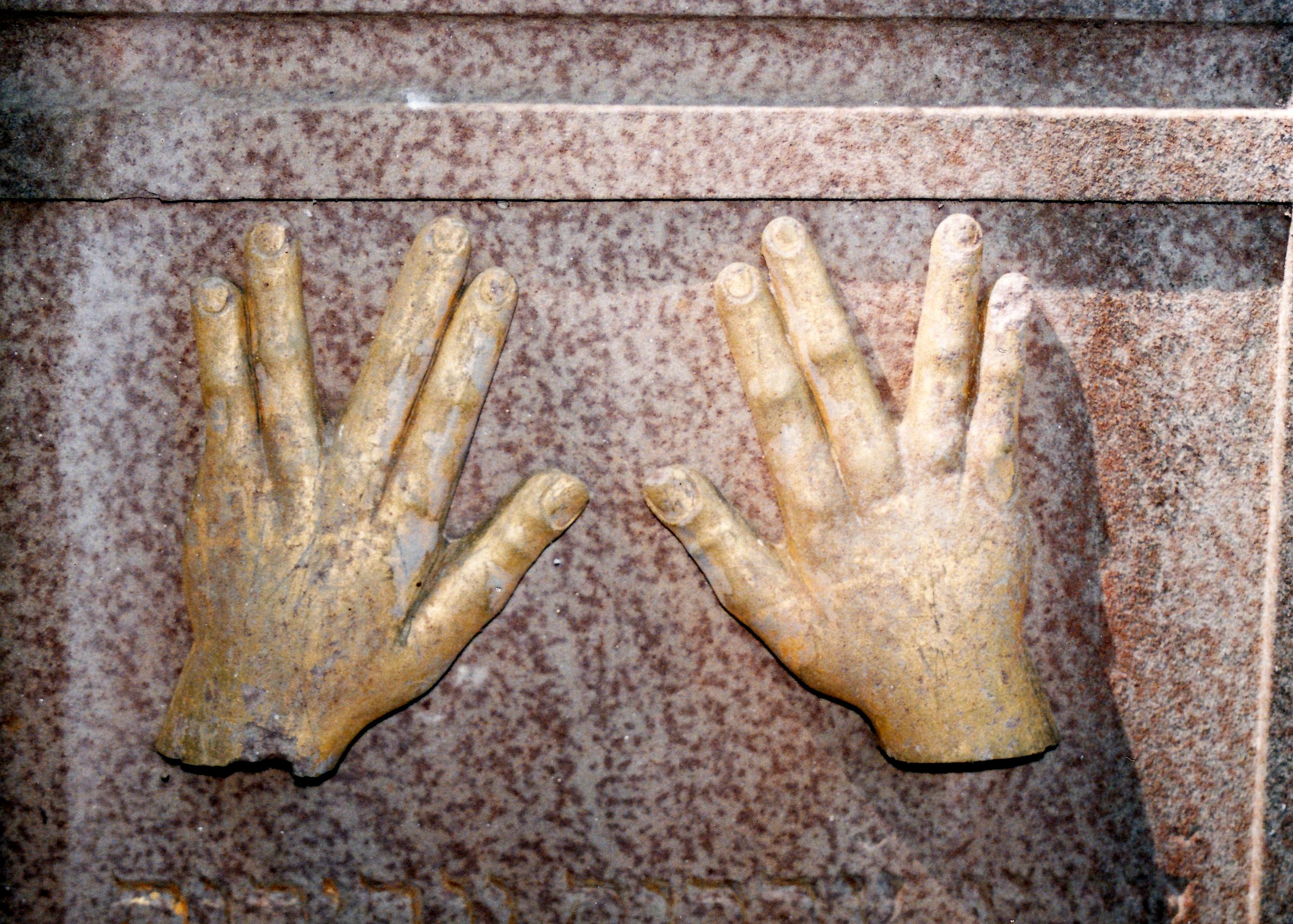
| 
 Date? - Segnende Hände der Kohanim auf einem Grabstein, Baisingen (Germany). "On Jewish tombstones you will sometimes see a symbol showing two hands arranged for the Priestly Blessing like the example here. This is a symbol of the Kohen or Cohen (Hebrew for priest). The plural form is Kohanim or Cohanim. Kohanim are assumed to be direct male descendants of Aaron, who was the first Kohen and the brother of Moses. Some Jewish surnames frequently associated with this symbol are Conn or Cohn (Kohn), Cahn (Kahn), and Cohen (Kohen), but you will find the symbol on the grave markers of people with other surnames."
Date? - Segnende Hände der Kohanim auf einem Grabstein, Baisingen (Germany). "On Jewish tombstones you will sometimes see a symbol showing two hands arranged for the Priestly Blessing like the example here. This is a symbol of the Kohen or Cohen (Hebrew for priest). The plural form is Kohanim or Cohanim. Kohanim are assumed to be direct male descendants of Aaron, who was the first Kohen and the brother of Moses. Some Jewish surnames frequently associated with this symbol are Conn or Cohn (Kohn), Cahn (Kahn), and Cohen (Kohen), but you will find the symbol on the grave markers of people with other surnames."
|

|  June 2001 - Peace & Friendship Monument, Arlington Park, Bad Königshofen (Germany). Celebrates sister city relationship with Arlington, Texas (USA). June 2001 - Peace & Friendship Monument, Arlington Park, Bad Königshofen (Germany). Celebrates sister city relationship with Arlington, Texas (USA).  
|


|   July 12, 2003 - International Peace & Friendship Monument, Arlington Museum of Art, Arlington, Texas (USA). Similar monument in sister city Bad Königshofen (Germany). July 12, 2003 - International Peace & Friendship Monument, Arlington Museum of Art, Arlington, Texas (USA). Similar monument in sister city Bad Königshofen (Germany). 
|


|  Date? - Friedensstupa / Stupa for World Peace, Kamalashila Institute, at a castle thirty kilometers west of Bonn and Cologne (Germany). Date? - Friedensstupa / Stupa for World Peace, Kamalashila Institute, at a castle thirty kilometers west of Bonn and Cologne (Germany).
|


|  Date? - ? (Germany?). Date? - ? (Germany?).
|

| B
R
ID
G
E |   2004 - Passerelle des Deux Rives / Gateway of the Two Banks, across Rhine River between Strasbourg (France) & Kehl (Germany). 2004 - Passerelle des Deux Rives / Gateway of the Two Banks, across Rhine River between Strasbourg (France) & Kehl (Germany).
 "Permanent artistic installation, a bond between two countries for which the border formerly seemed & wanted to be insuperable. According to Roland Ries, then mayor of Strasbourg, 'Here, it is indeed Europe, because this bridge connects two countries that have been torn apart for a long time; the reconciliation of these two countries is today one of the surest supports of the European construction.'" Not to be confused with the Bridge of Europe which is a highway bridge a few hundred meters downstream (right image). "Permanent artistic installation, a bond between two countries for which the border formerly seemed & wanted to be insuperable. According to Roland Ries, then mayor of Strasbourg, 'Here, it is indeed Europe, because this bridge connects two countries that have been torn apart for a long time; the reconciliation of these two countries is today one of the surest supports of the European construction.'" Not to be confused with the Bridge of Europe which is a highway bridge a few hundred meters downstream (right image). 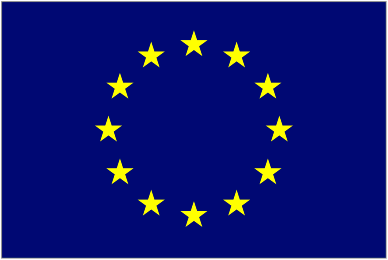
| 
|
  
 |  July 8-18, 2004 - Peace Bell, 3rd Choir Olympics, Bremen (Germany). "The Hanseatic city of Bremen continued the success story of the Choir Olympics, proving to be an excellent host of the world’s biggest choir competition. The closeness of the event locations and the compact setting of the city center created an unbelievable atmosphere. Music was made and sung on every street corner of the city center, so that one could truly take the Choir Olympic Idea completely literally: singing together brings nations together.
Patron: Dr. Henning Scherf, President of the Senate of the Free Hanseatic City of Bremen.
July 8-18, 2004 - Peace Bell, 3rd Choir Olympics, Bremen (Germany). "The Hanseatic city of Bremen continued the success story of the Choir Olympics, proving to be an excellent host of the world’s biggest choir competition. The closeness of the event locations and the compact setting of the city center created an unbelievable atmosphere. Music was made and sung on every street corner of the city center, so that one could truly take the Choir Olympic Idea completely literally: singing together brings nations together.
Patron: Dr. Henning Scherf, President of the Senate of the Free Hanseatic City of Bremen.
|
 |  November 19, 2005 - Memorial to Deserters, Lehrertal entrance, university botanical garden, Ulm (Germany). Creation of Hannah Stuetz Menzel. Memorializes men who deserted the Wehrmacht during World War II. (15,000 were executed.) Information courtesy of Mark Hatlie.
November 19, 2005 - Memorial to Deserters, Lehrertal entrance, university botanical garden, Ulm (Germany). Creation of Hannah Stuetz Menzel. Memorializes men who deserted the Wehrmacht during World War II. (15,000 were executed.) Information courtesy of Mark Hatlie.
|

|  2006 - Friedensdenkmal / Peace Monument, Auerstedt. Thuringia (Germany). 2006 - Friedensdenkmal / Peace Monument, Auerstedt. Thuringia (Germany).
|
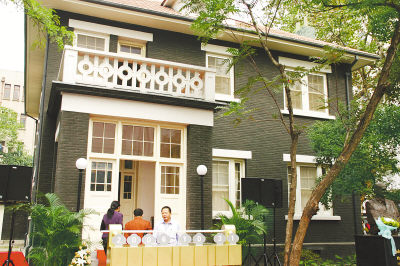 | 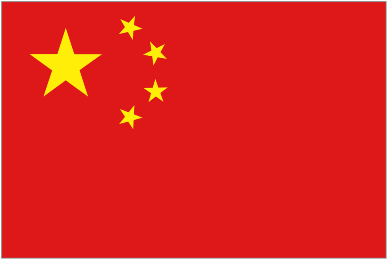 2006 - "John Rabe & International Safety Zone Memorial Hall," Nanjing University, Nanjing (China). Contains "John Rabe International Research & Exchange Center for Peace and Reconciliation." John Rabe [1882-1950], "the good Nazi," was a German businessman who is best known for his efforts to stop the atrocities of the Japanese army during the Nanking Massacre. 2006 - "John Rabe & International Safety Zone Memorial Hall," Nanjing University, Nanjing (China). Contains "John Rabe International Research & Exchange Center for Peace and Reconciliation." John Rabe [1882-1950], "the good Nazi," was a German businessman who is best known for his efforts to stop the atrocities of the Japanese army during the Nanking Massacre.

|


|  2007 - Solar Peace Sculpture, Saarbrüken (Germany). Sponsored by Matter of Trust (San Francisco). Sculpted by Fred George (Saarbrüken & New York City). "Appeals to the global citizen as well as politicians around the world. Symbolically, in addition to the commentary on current wars, this piece represents a call to the world to embrace alternative energies. Standing 50 feet tall Constructed of 120 oil barrels, with a solar energy panel mounted on each barrel. The solar energy produced from the panels will feed into the electrical grid of the city, with the monthly proceeds donated to various local charities. Current proposal locations include Saarbrüken, New York City & Shanghai." 2007 - Solar Peace Sculpture, Saarbrüken (Germany). Sponsored by Matter of Trust (San Francisco). Sculpted by Fred George (Saarbrüken & New York City). "Appeals to the global citizen as well as politicians around the world. Symbolically, in addition to the commentary on current wars, this piece represents a call to the world to embrace alternative energies. Standing 50 feet tall Constructed of 120 oil barrels, with a solar energy panel mounted on each barrel. The solar energy produced from the panels will feed into the electrical grid of the city, with the monthly proceeds donated to various local charities. Current proposal locations include Saarbrüken, New York City & Shanghai."
|
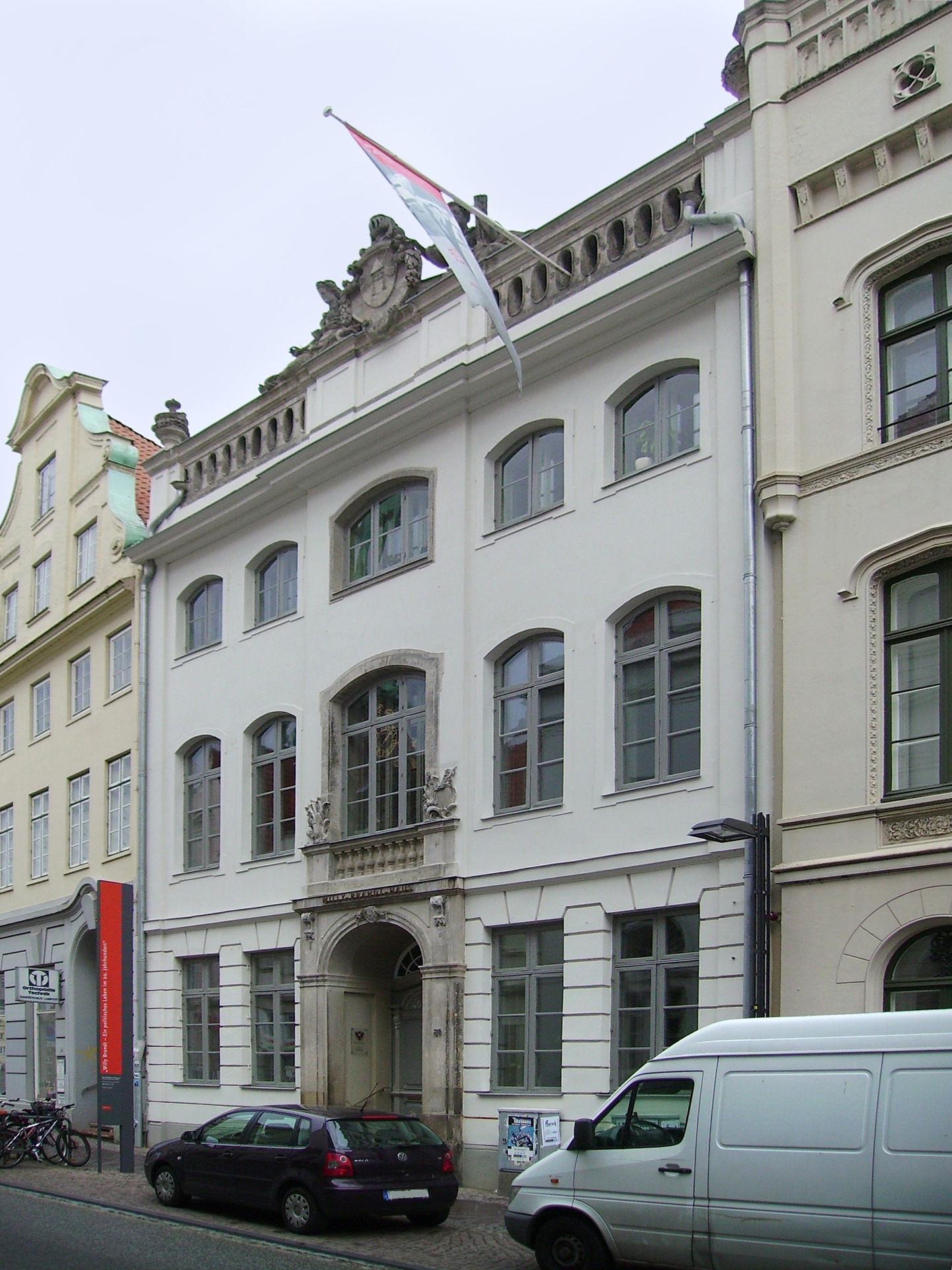
 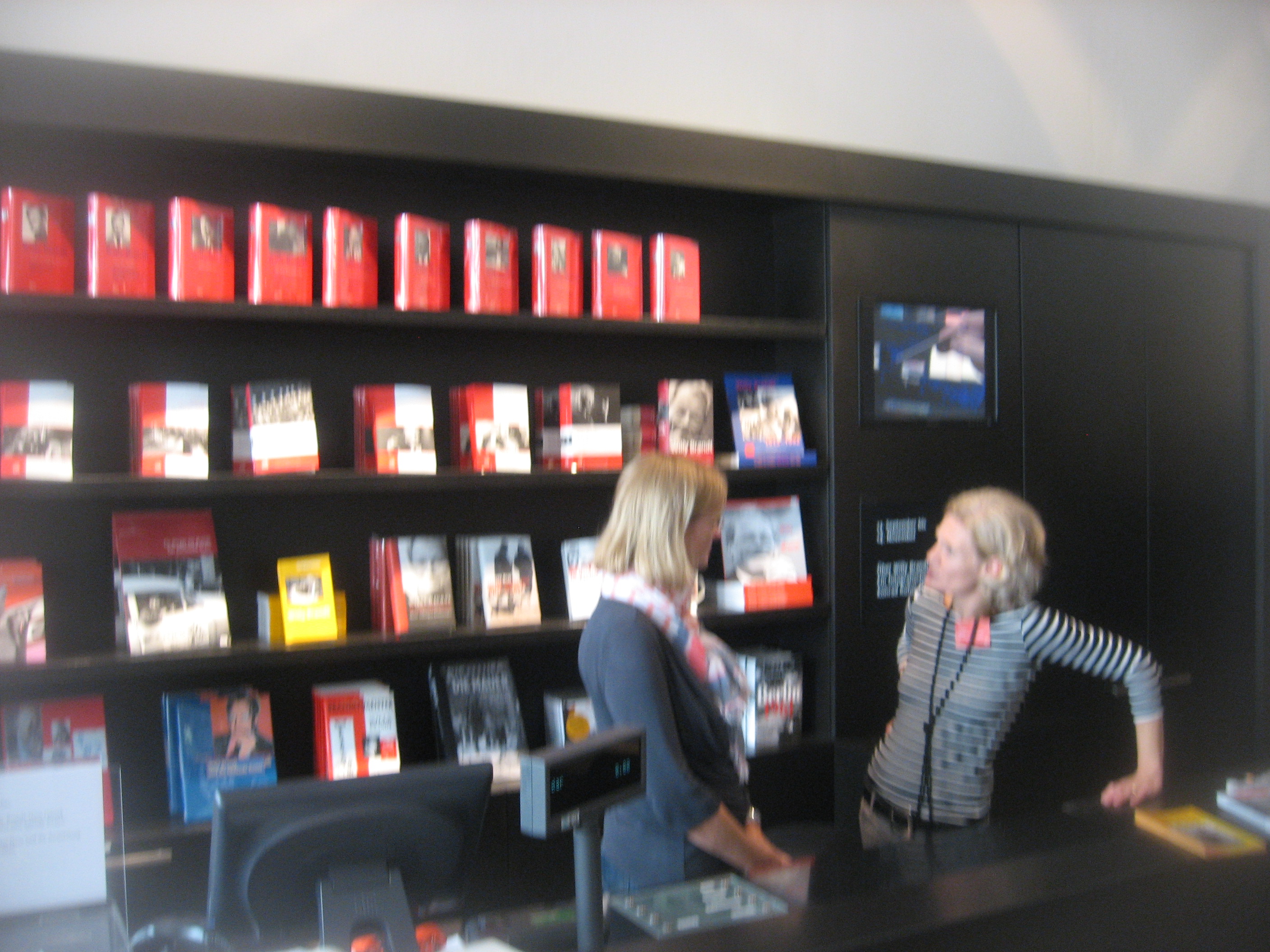

|  2007 - Willy-Brandt-Haus Lübeck / Willy Brandt Museum Lübeck, Königstraße 21, Lübeck (Germany). "Federal chancellor & Nobel peace prize laureate Willy Brandt, born in Lübeck, was doubtlessly one of the city's most distinguished sons. This extensive permanent exhibition with numerous original objects is dedicated to the politician's career, his time as the West German head of government, his private life and his commitment to peace & human rights. Through the garden, where a segment of the Berlin Wall is on display, the museum is connected to the Günter-Grass-Haus. The building itself is a 18th-century town house, once the seat of the municipal archive and highly impressive in its own right." Right image by EWL. 2007 - Willy-Brandt-Haus Lübeck / Willy Brandt Museum Lübeck, Königstraße 21, Lübeck (Germany). "Federal chancellor & Nobel peace prize laureate Willy Brandt, born in Lübeck, was doubtlessly one of the city's most distinguished sons. This extensive permanent exhibition with numerous original objects is dedicated to the politician's career, his time as the West German head of government, his private life and his commitment to peace & human rights. Through the garden, where a segment of the Berlin Wall is on display, the museum is connected to the Günter-Grass-Haus. The building itself is a 18th-century town house, once the seat of the municipal archive and highly impressive in its own right." Right image by EWL.  /// Museum appears to be very well funded & offers free admission. Many books for sale on three walls around the reception desk.
/// Museum appears to be very well funded & offers free admission. Many books for sale on three walls around the reception desk.
|

|  Date? Air Raid Monument, Hamburger Strasse, Hamburg (Germany). "The inscription on this memorial reads, 'On the night of 29 July 1943, 370 persons perished in the air-raid shelter on the Hamburgerstrasse in a bombing raid. Remember these dead. Never again fascism. Never again war.'" Date? Air Raid Monument, Hamburger Strasse, Hamburg (Germany). "The inscription on this memorial reads, 'On the night of 29 July 1943, 370 persons perished in the air-raid shelter on the Hamburgerstrasse in a bombing raid. Remember these dead. Never again fascism. Never again war.'"
|


|  August 30, 2007 - Memorial to Deserters, Theaterhaus, Stuttgart (Germany). Smaller "postive" figure in front of larger "negative" figure. Awaits a more permanent location in downtown Stuttgart. NB: More than 15,000 men were executed for desertion by the Nazi regime. This monument was opposed by all political parties. The federal government argued that "Deserters are people who avoid their responsibility to the community." Info & Image from Mark Hatlie. August 30, 2007 - Memorial to Deserters, Theaterhaus, Stuttgart (Germany). Smaller "postive" figure in front of larger "negative" figure. Awaits a more permanent location in downtown Stuttgart. NB: More than 15,000 men were executed for desertion by the Nazi regime. This monument was opposed by all political parties. The federal government argued that "Deserters are people who avoid their responsibility to the community." Info & Image from Mark Hatlie. 
|


| D E N K M A L
 September 1, 2009 - Deserteurdenkmal / Deserter Monument, Cologne (Germany). "Pays tribute in the form of a pergola of Swiss designer Ruedi Baur to deserters & war opponents from the time of National Socialism.
Stands equidistant from 3 historically relevant buildings: The former armory (now a building of the Cologne City Museum), the EL-DE Haus, which ran the Gestapo once their torture chamber (now the Nazi Documentation Center) & the Administrative Court, were convicted in the building during the Nazi than a hundred people to death. 104 soldiers deserted in Cologne, mostly as a permanent so-called 'desertion,' sometimes only temporarily ('Unauthorized Removal'). In almost all cases, they were soldiers from the lower ranks.
To read the inscription on the monument must be turned upward glance, it shows its text apparently written in the sky, without a solid background in colored aluminum letters on an area of 8 by 4 meters.
Inscribed on the monument: 'Homage to the soldiers who refused to fire on the soldiers who refused to kill the people who refused to torture the people who refused to denounce the people who refused to brutalize people who refused to discriminate against people who refused to laugh at the people who showed courage, as the silent majority and followed.' [Google translation]" Info courtesy of Peter van den Dungen. September 1, 2009 - Deserteurdenkmal / Deserter Monument, Cologne (Germany). "Pays tribute in the form of a pergola of Swiss designer Ruedi Baur to deserters & war opponents from the time of National Socialism.
Stands equidistant from 3 historically relevant buildings: The former armory (now a building of the Cologne City Museum), the EL-DE Haus, which ran the Gestapo once their torture chamber (now the Nazi Documentation Center) & the Administrative Court, were convicted in the building during the Nazi than a hundred people to death. 104 soldiers deserted in Cologne, mostly as a permanent so-called 'desertion,' sometimes only temporarily ('Unauthorized Removal'). In almost all cases, they were soldiers from the lower ranks.
To read the inscription on the monument must be turned upward glance, it shows its text apparently written in the sky, without a solid background in colored aluminum letters on an area of 8 by 4 meters.
Inscribed on the monument: 'Homage to the soldiers who refused to fire on the soldiers who refused to kill the people who refused to torture the people who refused to denounce the people who refused to brutalize people who refused to discriminate against people who refused to laugh at the people who showed courage, as the silent majority and followed.' [Google translation]" Info courtesy of Peter van den Dungen.
|



|  2010 -
"Friedenszeichen / Peace signs," Georgswiese near Ippenburg Castle, Bad Essen, District of Osnabrück, Lower Saxony (Germany). "Of all 27 states of the European Union on the "Golf Lovers Kalkriese site in the year of the 2000th Anniversary of the Battle (2009)."
Battle of the Teutoburg Forest in 9 AD.
The campaign FELDZEICHEN ZU FRIEDENSZEICHEN (TURNING ROMAN STANDARDS INTO PEACE SYMBOLS) opened »2,000 Years Varus Battle«. During the many sessions of this campaign, more than 10,000 citizens from the county of Osnabrück individually designed 2,000 peace symbols. Their appearance is based on Roman army standards, and they decorated Kalkriese’s museum park in January. Staged in an impressive laser show, these peace symbols created a stunning atmosphere in the museum’s park.
Later on, they traveled on as »ambassadors of peace« and can now be found all over the county of Osnabrück. 27 peace symbols – one for each member country of the European Union – could also send their peace message from their locations in front of the European Parliament in Strasbourg and Deutscher Bundestag in Berlin.
Even 2001 years after the Varus Battle, the journey of the peace symbols continues. Under the title »Dem Frieden gewachsen?!« (»Being up to peace?!«), 194 of the peace symbols with peace-related quotes from 193 member nations of the United Nations as well as the Vatican will send out their peaceful message during the Landesgartenschau / State Garden Show at Bad Essen. From March 16, 2010 onward, the 194 steles will be set up as attractions in two locations: in Bad Essen’s town center with its historical churchyard and on the Georgswiese near Ippenburg Castle. There they will remind us of the nations’ shared responsibility for peace on this planet.
Responsible for concept and design of these modern army standards is Osnabrück-based artist Volker Johannes Trieb. Thanks to the unremitting dedication of many youth workshops, in particular that of Brücke Bramsche e. V., the dedication of schools as well as towns and communities, these symbols could unfold their power as signposts of peace. 2010 -
"Friedenszeichen / Peace signs," Georgswiese near Ippenburg Castle, Bad Essen, District of Osnabrück, Lower Saxony (Germany). "Of all 27 states of the European Union on the "Golf Lovers Kalkriese site in the year of the 2000th Anniversary of the Battle (2009)."
Battle of the Teutoburg Forest in 9 AD.
The campaign FELDZEICHEN ZU FRIEDENSZEICHEN (TURNING ROMAN STANDARDS INTO PEACE SYMBOLS) opened »2,000 Years Varus Battle«. During the many sessions of this campaign, more than 10,000 citizens from the county of Osnabrück individually designed 2,000 peace symbols. Their appearance is based on Roman army standards, and they decorated Kalkriese’s museum park in January. Staged in an impressive laser show, these peace symbols created a stunning atmosphere in the museum’s park.
Later on, they traveled on as »ambassadors of peace« and can now be found all over the county of Osnabrück. 27 peace symbols – one for each member country of the European Union – could also send their peace message from their locations in front of the European Parliament in Strasbourg and Deutscher Bundestag in Berlin.
Even 2001 years after the Varus Battle, the journey of the peace symbols continues. Under the title »Dem Frieden gewachsen?!« (»Being up to peace?!«), 194 of the peace symbols with peace-related quotes from 193 member nations of the United Nations as well as the Vatican will send out their peaceful message during the Landesgartenschau / State Garden Show at Bad Essen. From March 16, 2010 onward, the 194 steles will be set up as attractions in two locations: in Bad Essen’s town center with its historical churchyard and on the Georgswiese near Ippenburg Castle. There they will remind us of the nations’ shared responsibility for peace on this planet.
Responsible for concept and design of these modern army standards is Osnabrück-based artist Volker Johannes Trieb. Thanks to the unremitting dedication of many youth workshops, in particular that of Brücke Bramsche e. V., the dedication of schools as well as towns and communities, these symbols could unfold their power as signposts of peace.
|
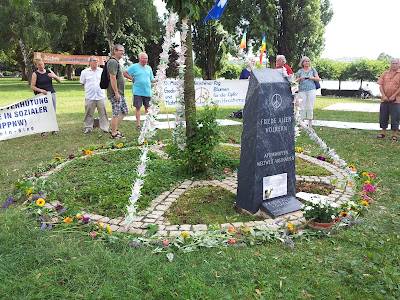 |  April 8, 2011 -
Hiroshima-Denkmal / Hiroshima Monument, Rhine River, Bonn-Beuel (Germany). Inscription: "Hiroshima 6.8.1945. Friede Allen Volkern. Atomwaffen weltweit abschaffen" (translation: "Peace to all peoples. Abolish nuclear weapons worldwide"). Click here for video of dedication. Information courtesy of Peter van den Dungen. April 8, 2011 -
Hiroshima-Denkmal / Hiroshima Monument, Rhine River, Bonn-Beuel (Germany). Inscription: "Hiroshima 6.8.1945. Friede Allen Volkern. Atomwaffen weltweit abschaffen" (translation: "Peace to all peoples. Abolish nuclear weapons worldwide"). Click here for video of dedication. Information courtesy of Peter van den Dungen.
|

|  October 21, 2012 - Jerusalem-Friedensstein / Jerusalem Rock of Peace, Bensheim-Hochstädten, near Frankfurt (Germany). "On the European long-distance hiking trail high above E8 cities." Inscribed "Wo sich Staub zu Licht wandelt"/"Where dust to light converts." /// "'Jerusalem is everywhere where there is beauty. And now Jerusalem is also in Bensheim near Frankfurt.'" - this is the message that the Frankfurt Rabbi Andrew Steiman conveyed in his greeting at the inauguration of the Rock of Peace. But Jerusalem did not stay in Bensheim for long. Only nine days after the inauguration, the Jerusalem Rock of Peace was desecrated. Thomas Zieringer, the initiator of the monument, said that this site also stood for the idea that remembrance should not be reserved for the past, but should signify that we are moving forward into a new concord in peace. The intention had been to build a monument for peace that links the idea of outer peace with that of inner peace." October 21, 2012 - Jerusalem-Friedensstein / Jerusalem Rock of Peace, Bensheim-Hochstädten, near Frankfurt (Germany). "On the European long-distance hiking trail high above E8 cities." Inscribed "Wo sich Staub zu Licht wandelt"/"Where dust to light converts." /// "'Jerusalem is everywhere where there is beauty. And now Jerusalem is also in Bensheim near Frankfurt.'" - this is the message that the Frankfurt Rabbi Andrew Steiman conveyed in his greeting at the inauguration of the Rock of Peace. But Jerusalem did not stay in Bensheim for long. Only nine days after the inauguration, the Jerusalem Rock of Peace was desecrated. Thomas Zieringer, the initiator of the monument, said that this site also stood for the idea that remembrance should not be reserved for the past, but should signify that we are moving forward into a new concord in peace. The intention had been to build a monument for peace that links the idea of outer peace with that of inner peace."
|
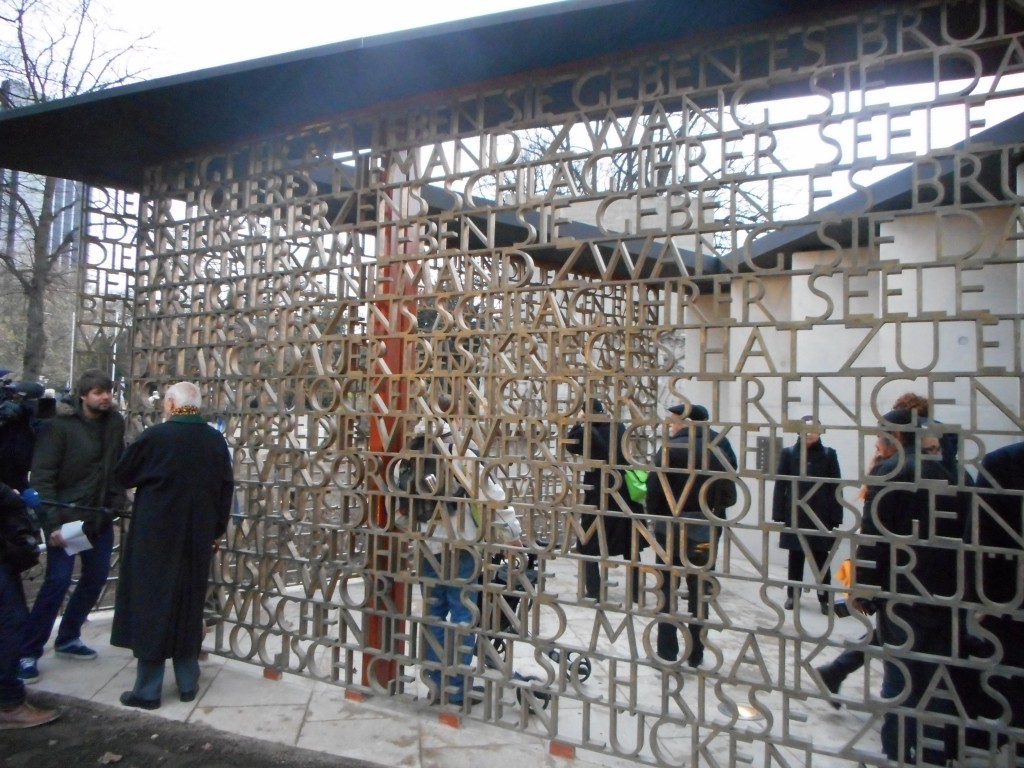 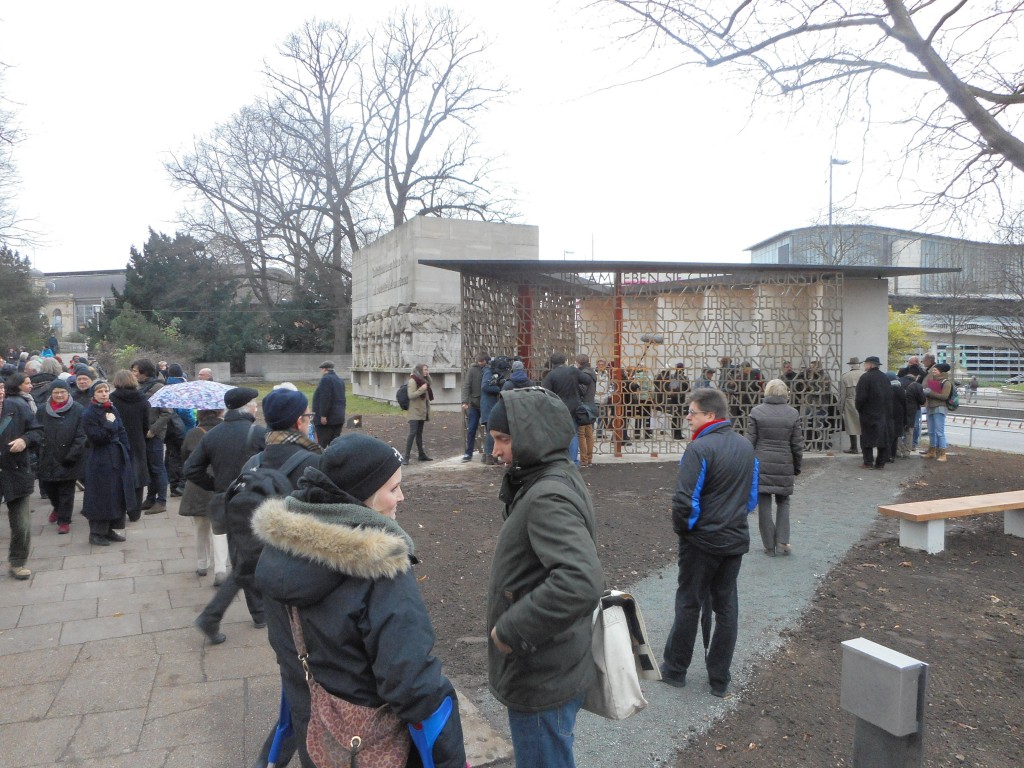
 |
 November 24, 2015 - Deserteursdenkmal / Deserters Monument, City Center, Hamburg (Germany). Google translation: "For deserters & other victims of Nazi military justice. Before the war Klotz now stands a small wall with the inscription: 'The Second World War was a war of extermination and Anggriffs-, an indebted by Nazi Germany crimes' [and] the words Helmut Heissenbuttel [1921-1996]... completed by an integrated Hörcollage, grows with biographical data of those executed. All in all a thoroughly exciting and modern memorial installation. Pity the Hannover did not have to go a similar way open heart..." /// Information courtesy of Gerard Lössbroek (Pax Christi International). November 24, 2015 - Deserteursdenkmal / Deserters Monument, City Center, Hamburg (Germany). Google translation: "For deserters & other victims of Nazi military justice. Before the war Klotz now stands a small wall with the inscription: 'The Second World War was a war of extermination and Anggriffs-, an indebted by Nazi Germany crimes' [and] the words Helmut Heissenbuttel [1921-1996]... completed by an integrated Hörcollage, grows with biographical data of those executed. All in all a thoroughly exciting and modern memorial installation. Pity the Hannover did not have to go a similar way open heart..." /// Information courtesy of Gerard Lössbroek (Pax Christi International).
|
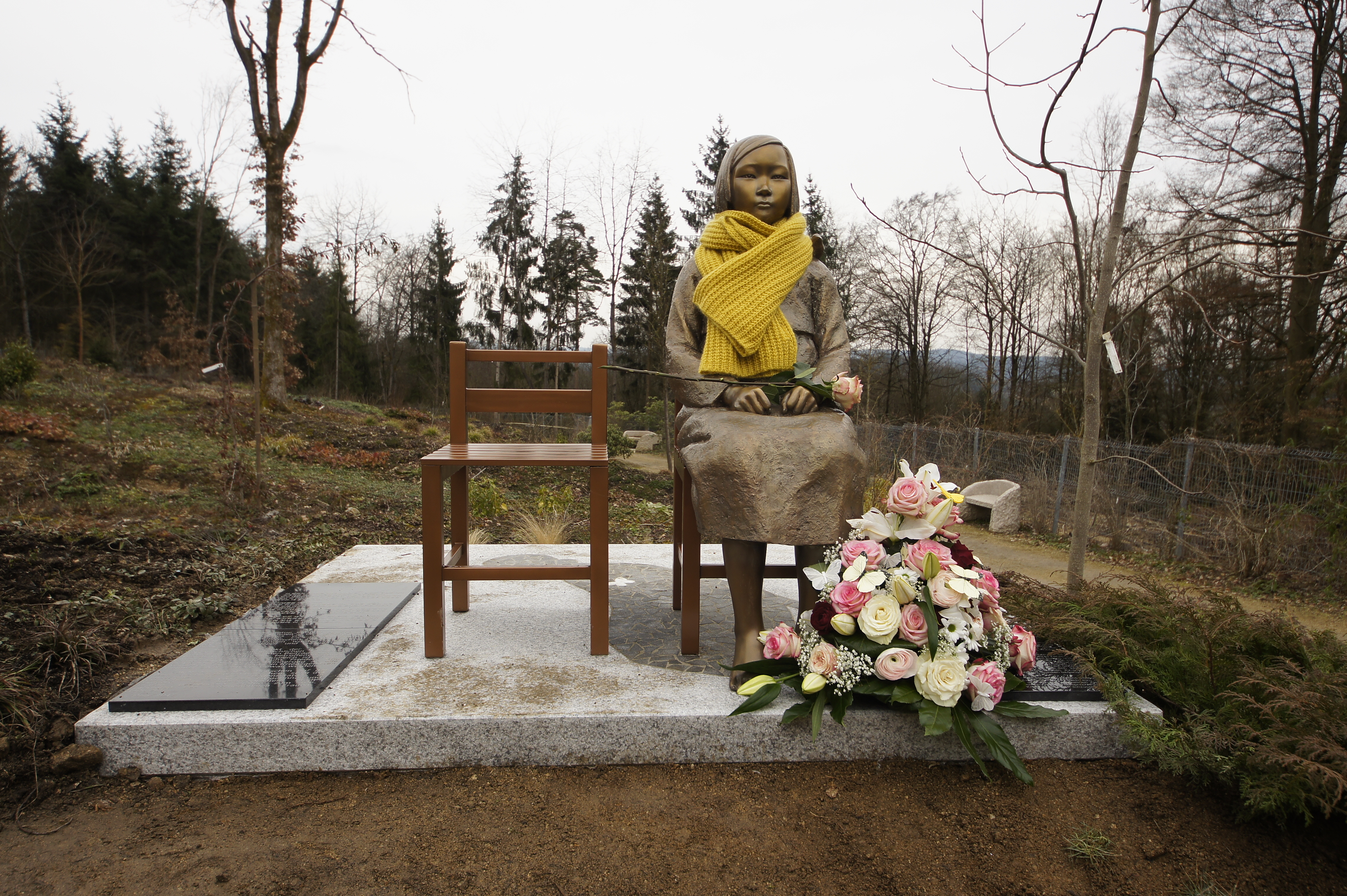 |  March 8, 2017 - Friedensstatue / Comfort Women Monument, Nepal Himalaya Pavillon, Wiesent, Regensburg District, Bavaria (Germany). First comfort women statue in Europe. "Present at the [dedication] ceremony were some 100 local German officials as well as representatives from South Korea’s Suwon city government & civic groups from South Korea... Yonhap [News Agency] said there are currently over 40 comfort women statues erected in & outside of South Korea, including in the USA, Canada, Australia & China.
Suwon city had initially agreed with Freiburg, another German city, last July to set up a comfort woman statue there, but the plan was scuttled apparently due to 'strong obstruction & pressure' by Japan, according to Yonhap." Information courtesy of Gerard Lössbroek (Pax Christi International). March 8, 2017 - Friedensstatue / Comfort Women Monument, Nepal Himalaya Pavillon, Wiesent, Regensburg District, Bavaria (Germany). First comfort women statue in Europe. "Present at the [dedication] ceremony were some 100 local German officials as well as representatives from South Korea’s Suwon city government & civic groups from South Korea... Yonhap [News Agency] said there are currently over 40 comfort women statues erected in & outside of South Korea, including in the USA, Canada, Australia & China.
Suwon city had initially agreed with Freiburg, another German city, last July to set up a comfort woman statue there, but the plan was scuttled apparently due to 'strong obstruction & pressure' by Japan, according to Yonhap." Information courtesy of Gerard Lössbroek (Pax Christi International).
|



|  May 14, 2017 -
"On the Leuner Dollberg and its design to a memorial to peace." "Above Leun, Lahn-Dill-Kreis, Hesse (Germany), on the Dollberg, originally in view of the place, the Kriegserverein established 1889."
" A monument to the heroic emperors, Wilhelm I and Friedrich III, with which also the four Leuner citizens who had fallen in 1870/71 were thought. "
This is how the Landamt für Denkmalpflege describes our monument:
'A cone-shaped mound, covered with large lime trees, forms the base for a steep pyramid, which is crowned by basalt columns, crowned by a bronze eagle. The conscious staging of the monument is reinforced by the axial staircase.'"
/// "Cordial invitation.
For the inauguration of the Leuner Memorial on 14 May 2017.
program:
12.30 hrs -
Opportunity for a snack.
1.30 pm -
Greetings and speeches,
Revelation of the eagle,
Lectures by the Wackenbachler.
Approximately 3 pm -
A nice time together
With coffee and cake.
On this day we give the erected memorial of his destiny:
Is intended to make history comprehensible, as a landmark of our city, and to remember how important it is to maintain peace among the peoples.
We look forward to your visit.
DenkMal Working Group." One of 15 peace monuments found in July 2017 by Googling "Friedensdenkmal" or "Friedensmahnmal." May 14, 2017 -
"On the Leuner Dollberg and its design to a memorial to peace." "Above Leun, Lahn-Dill-Kreis, Hesse (Germany), on the Dollberg, originally in view of the place, the Kriegserverein established 1889."
" A monument to the heroic emperors, Wilhelm I and Friedrich III, with which also the four Leuner citizens who had fallen in 1870/71 were thought. "
This is how the Landamt für Denkmalpflege describes our monument:
'A cone-shaped mound, covered with large lime trees, forms the base for a steep pyramid, which is crowned by basalt columns, crowned by a bronze eagle. The conscious staging of the monument is reinforced by the axial staircase.'"
/// "Cordial invitation.
For the inauguration of the Leuner Memorial on 14 May 2017.
program:
12.30 hrs -
Opportunity for a snack.
1.30 pm -
Greetings and speeches,
Revelation of the eagle,
Lectures by the Wackenbachler.
Approximately 3 pm -
A nice time together
With coffee and cake.
On this day we give the erected memorial of his destiny:
Is intended to make history comprehensible, as a landmark of our city, and to remember how important it is to maintain peace among the peoples.
We look forward to your visit.
DenkMal Working Group." One of 15 peace monuments found in July 2017 by Googling "Friedensdenkmal" or "Friedensmahnmal."
|
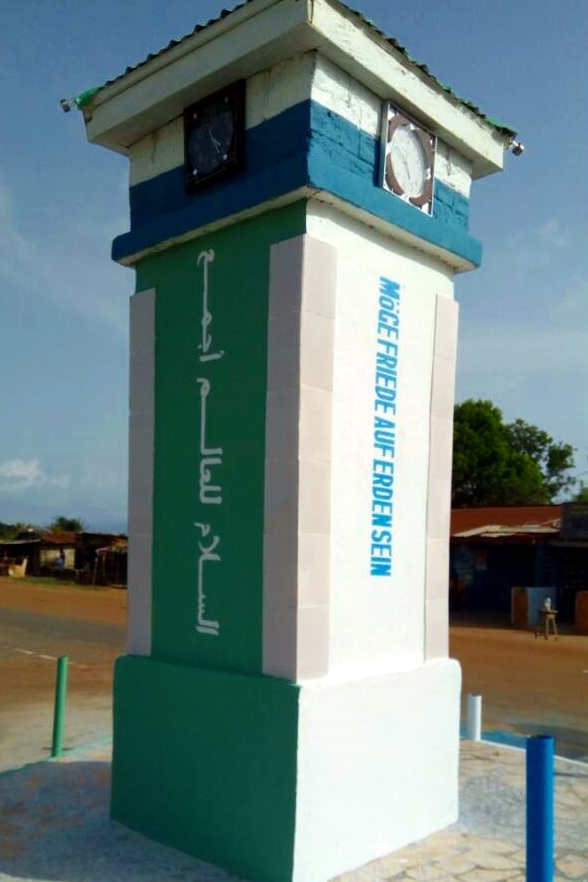

|  June 4, 2017 - Peace Pole, _____ (Sierra Leone). "Möge Frieden auf Erden sein." "May peace prevail on earth." /// "Forikolo e.V. erected a peace monument in Sierra Leone. On the monument is written in English, French, Arabic and German: 'May peace be on earth.' The colors of the monument, green, white & blue, are the colors of the country flag... In Sierra Leone, a 10-year civil war, which ended officially in 2002, demanded tens of thousands of death sacrifices & still characterize the lives of the people...
We have built the Peace Monument on the initiative of Otto Herz, a member of Forikolo e.V. & has been committed to global humanity & solidarity for many years. [Google translation]." /// Forikolo e.V. is a Germany organization which builds & operates schools in Sierra Leone. It's not clear from the web exactly where this monument was constructed. June 4, 2017 - Peace Pole, _____ (Sierra Leone). "Möge Frieden auf Erden sein." "May peace prevail on earth." /// "Forikolo e.V. erected a peace monument in Sierra Leone. On the monument is written in English, French, Arabic and German: 'May peace be on earth.' The colors of the monument, green, white & blue, are the colors of the country flag... In Sierra Leone, a 10-year civil war, which ended officially in 2002, demanded tens of thousands of death sacrifices & still characterize the lives of the people...
We have built the Peace Monument on the initiative of Otto Herz, a member of Forikolo e.V. & has been committed to global humanity & solidarity for many years. [Google translation]." /// Forikolo e.V. is a Germany organization which builds & operates schools in Sierra Leone. It's not clear from the web exactly where this monument was constructed.  One of 15 peace monuments found in July 2017 by Googling "Friedensdenkmal" or "Friedensmahnmal." One of 15 peace monuments found in July 2017 by Googling "Friedensdenkmal" or "Friedensmahnmal."
|



|  Future - Monument to the unknown deserter, Nottuln, North Rhine-Westphalia (Germany). "FI Nottuln plans a monument to the unknown deserter. For many years, FI Nottuln [has been interested in] the issue of desertion.
This is a reclamation of a historical theme -- desertion in World War II -- also known as resistance against National Socialism.
And it deals with desertion today -- the still existing obligation [of being] forced to kill. It is [also] about the so-called military service." Future - Monument to the unknown deserter, Nottuln, North Rhine-Westphalia (Germany). "FI Nottuln plans a monument to the unknown deserter. For many years, FI Nottuln [has been interested in] the issue of desertion.
This is a reclamation of a historical theme -- desertion in World War II -- also known as resistance against National Socialism.
And it deals with desertion today -- the still existing obligation [of being] forced to kill. It is [also] about the so-called military service."
|
Note about mahnmal & denkmal
"Before WW-II there were no warning monuments [mahnmal] in Germany. Instead there were war memorials [denkmal], to fallen soldiers dying, like marble Christs, for the fatherland. The bonds of national community were strengthened through therir sacrifice. War, in Great War monuments, is a mystical experience, a Calvary of valor, sacrifice, and regeneration. Great Gothic memorial fortresses were built in the German Reich to pluck honor from defeat. Nothing like this emerged after WW-II. Insted, the Germans built monuments not to glorify but to warn; Denkmal became Mahnmal. /// Like a monumental rosary, spread mostly over western Germany, the monuments testify to a fretting over memory, a neutotic fear of amnesia, an obsession with casting the past in stone. It was not always like this. In the late 1940s and 1950s, the compulsion to forget was stronger. Reminders of the past -- not just Hitler's past -- were destroyed, blown up, removed. Sites of concentration camps were used for some time to house German prisoners, by Soviets and Western Allies alike, but as soon as was possible they were either razed or abandoned. What physically remained of the Third Reich was left out of apathy or force majeure, as in the case of Speer's indestructible Nuremberg stadium, or for political reasons, as was usually the case in East Germany. The warning monuments [mahnmal] and memorial places (Gedenkstatte) are mostly products of the reaction, which set in during the 1960s, propelled by the postwar generation, as eager to warn and remember as their parents were to forget." [Ian Buruma (1994), "The Wages of Guilt," pp. 203-4.]
Please email your comments & questions to geovisual at comcast.net. Thank you.
Return to Peace Monuments main page.







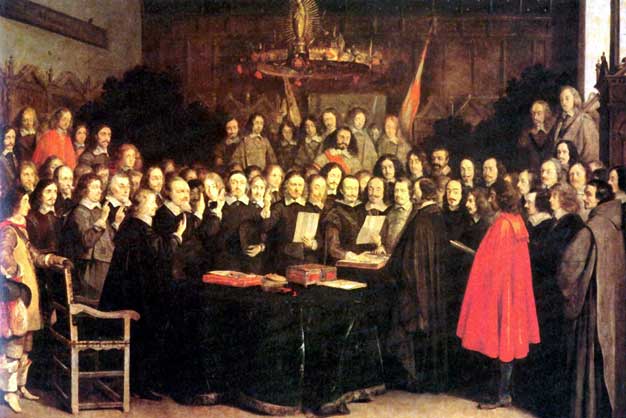










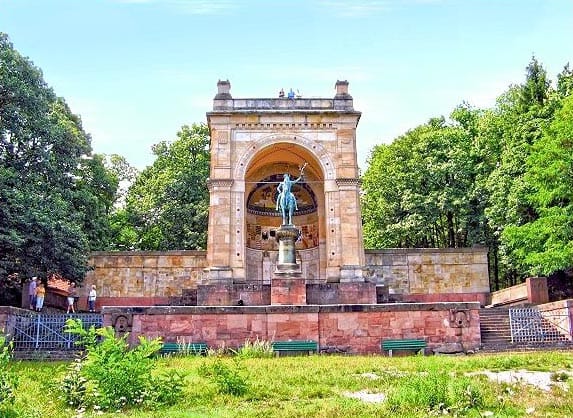










































































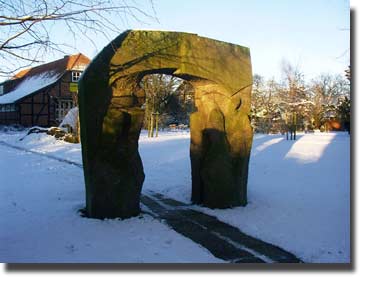


.jpg)























































